Energy Systems in Transition: A Regional Analysis of Eastern Europe’s Energy Challenges
Abstract
1. Introduction
2. Materials and Methods
2.1. Data Preparation and Normalisation
2.2. Principal Component Analysis (PCA)
2.3. Cluster Analysis
2.4. Regression Analysis
2.5. Data and Time Period
- IEA (International Energy Agency) [32]: Primarily energy balances, primary energy sources, and electricity mix data.
- Eurostat [33]: Detailed statistics on energy consumption broken down by sector (industry, households, transport, services).
- EEA (European Environment Agency) [34]: Annual reports on CO2 emissions and their sources.
- Bulgaria (BG);
- Croatia (CRO);
- Czech Republic (CZ);
- Hungary (HU);
- Poland (PL);
- Romania (RO);
- Slovakia (SK);
- Slovenia (SI).
2.6. Analysed Data Types
- Total energy supply (domestic energy production, energy import and exports, energy transformation, electricity generation, final energy consumption, energy consumption by sector).
- Total CO2 emissions from energy (share of global emissions, CO2 emissions from fuel combustion, per capita CO2 emissions, CO2 emissions by fuel, CO2 emissions by sector, electricity and heat producers).
- Sources of electricity generation (total electricity production, electricity imports and exports, CO2 emissions from power generation, per capita electricity consumption, final consumption of electricity).
- Share of renewables in energy consumption (share of modern renewables in final energy consumption, biofuels and waste, renewable electricity generation, hydro, renewable heat)
2.7. Indicators and Derived Metrics
2.7.1. Carbon Intensity (CO2 Intensity)
2.7.2. Energy Intensity
2.7.3. Import Ratio
2.7.4. Share of Renewables in Electricity Generation
2.7.5. Nuclear Energy Share and Coal Share in Electricity Generation
2.7.6. Novel Composite Indicator: Decarbonization Level Index (DLI)
2.7.7. Calculation Basis for the Planned Developments in the Energy Mix
3. Results
3.1. The Distribution of the Energy Mix (Production + Consumption)
- Cluster 1: High fossil-based production and consumption (BG, PL).
- Cluster 2: Combined nuclear and fossil energy mix (CZ, SK, HU).
- Cluster 3: Primarily renewable-based energy mix (SI, HR, partially RO).
3.2. Sectoral Breakdown of Final Energy Consumption
- In industry-heavy countries (high PC1 scores), deep decarbonisation will require large-scale process electrification, adoption of low-carbon fuels (e.g., hydrogen), and efficiency upgrades.
- In transport-intensive countries, the focus will need to be on accelerating vehicle electrification, improving public transit infrastructure, and expanding alternative fuel deployment.
- Transport + Residential-dominated countries.
- Industry-dominated countries.
- Countries with balanced sectoral distribution.
- Political factors (e.g., renewable subsidies, fuel taxation).
- Energy market volatility (e.g., oil/gas price shocks).
- Infrastructure disparities (grid capacity, interconnectivity).
- International trade in energy (import/export dependency).
3.3. Breakdown of Electricity Generation by Energy Source
- Electricity generation by fuel type: coal, gas, nuclear, hydro, solar photovoltaic, wind—electricity generation sources.
3.4. Energy Independence and Intensity
- Countries dominated by transport and residential sectors.
- Countries with high industrial energy consumption.
- Countries with a more balanced and diversified sectoral profile.
3.5. CO2 Emission Profiles
- Total CO2 emissions from fuel combustion (per capita or in Mt).
- CO2 emissions by sector: industry, transport, and electricity and heat generation.
- Cluster 1—High electricity sector emissions from fossil fuel-dependent generation (e.g., BG, PL).
- Cluster 2—Transport-dominated emissions with relatively low-carbon electricity generation (e.g., HR, SI).
- Cluster 3—Balanced or moderate emission profiles without a single dominant sector (e.g., HU, SK).
- PC1 has a significant positive effect (β = 0.8286, p = 0.002), underscoring its importance as a driver of per capita CO2 emissions—consistent with PC1’s representation of electricity and industrial sector emissions.
- PC2 has a positive but statistically insignificant coefficient (β = 0.4054, p = 0.300), indicating a supplementary role.
- Political and regulatory frameworks (e.g., renewable subsidies, carbon pricing mechanisms).
- Market structures and liberalisation levels, influencing investment in low-carbon generation.
- Economic shocks or fuel price volatility, which can alter short-term energy mix and consumption patterns.
3.6. Ranking by the Decarbonisation Level Index (DLI) Indicator
- Climate-focused scenario (w1 = 0.5, w2 = 0.2, w3 = 0.2, w4 = 0.1): Countries with lower CO2 intensity and balanced low-carbon portfolios perform more favourably. Bulgaria, Romania, and Slovenia exhibit negative DLI values, reflecting advantageous conditions for decarbonization due to relatively low emission intensities and substantial renewable/nuclear shares. In contrast, Hungary and Poland register the highest DLI values, indicating structural disadvantages in terms of emission intensity and import dependency.
- Energy-independence scenario (w1 = 0.2, w2 = 0.5, w3 = 0.2, w4 = 0.1): Here, import dependency dominates the assessment. Hungary emerges as the weakest performer (DLI = 24.6), followed by Poland and Slovakia, underlining their high reliance on external energy supplies. Romania (DLI = 7.2) and Bulgaria (11.0) rank more favourably, benefiting from a stronger domestic production base. These results confirm that energy security remains a central vulnerability for most of the region, particularly for landlocked states heavily dependent on gas imports.
- Renewables-focused scenario (w1 = 0.2, w2 = 0.2, w3 = 0.5, w4 = 0.1): This perspective fundamentally reshapes the ranking. Croatia, Slovenia, and Bulgaria record strongly negative DLI values, reflecting their substantial renewable penetration. Conversely, Poland and Hungary exhibit relatively low values, which indicate a lower level of renewable energy integration into their systems, despite the fact that both countries face significant decarbonization requirements.
- Resilient countries, represented only by Romania (RO), combine a low net import dependency (28.1%) with the lowest energy intensity (1716 MJ/USD), indicating an advantageous structural position in terms of efficiency and autonomy.
- Balanced countries such as the Czech Republic (CZ), Slovenia (SI), Poland (PL), and Bulgaria (BG) have moderate levels of imports and energy intensity. Although these countries are not particularly vulnerable, they would benefit from policy measures to increase energy efficiency and diversify energy sources.
- Vulnerable countries, including Hungary (HU), Slovakia (SK), and Croatia (HR), are highly dependent on energy imports (over 57%) and/or have high energy intensity. These factors indicate that their energy systems are more vulnerable to supply disruptions and external price shocks.
- The eight countries represent a subset of the EU’s total energy system; the EU27’s annual electricity consumption is roughly 3000 TWh (depending on the year).
- The estimated net energy change of ~120–140 TWh/year corresponds to roughly 4–5% of the EU’s total electricity consumption.
- The EU’s total annual CO2 emissions are about 2500–3000 Mt/year (all sectors, not just power).
- So, the 118.9–143.2 Mt CO2/year savings represent roughly 4–5% of the EU’s total CO2 emissions.
- Energy increase of ~120–140 TWh/year and CO2 savings of ~120–140 Mt/year in these eight countries is a significant contribution, but it is only part of the full EU picture.
4. Conclusions
- Integrated multivariate analysis: by applying advanced statistical methods such as Principal Component Analysis (PCA), clustering, and regression modelling to various energy indicators—including production, sectoral consumption, emissions profiles, and energy independence—the study reveals structural patterns and country groupings that go beyond simple country comparisons. This approach allows policy makers to identify customised intervention points that reflect the unique dynamics of each country’s energy system.
- Introduction of the Decarbonisation Level Index (DLI) indicator: The DLI summarises domestic energy production relative to consumption, coupled with decarbonisation and innovation metrics, providing a novel composite measure to assess energy security alongside climate targets. This indicator improves the ability to track progress towards energy independence and sustainability in an integrated framework.
- Explicit contextualisation within the EU policy framework: In contrast to much previous work, this study situates national energy strategies within the evolving EU regulatory landscape (e.g., “Clean Energy for All Europeans” and “Fit for 55”), and shows how these supranational policies contribute to, but do not fully resolve, the heterogeneity of the energy transition in the newer and older EU Member States in Eastern Europe.
- Forward-looking scenario analysis: The inclusion of quantified projections for nuclear capacity expansion, renewable energy growth, coal phase-out, and energy efficiency improvements through 2030 provides actionable insights into the potential scale of CO2 emissions reductions and energy security improvements. This is a valuable decision-making tool for aligning investments and policies with the EU’s climate targets.
- Data limitations and temporal coverage: The analysis relies on publicly available, harmonised datasets that mostly reflect the latest available years (mostly 2022–2023). Although this is necessary for comparability, this temporal snapshot may limit the ability to capture rapid or recent changes, such as those caused by geopolitical events or new technologies.
- Sample size and regional focus: The focus on eight selected Central and Eastern European countries provides depth and regional specificity, but limits the generalisability of the results to broader European or global contexts. Future extensions could include additional countries or cross-regional comparisons to validate and enrich the identified typologies.
- Lack of consideration of socio-economic and behavioural determinants: While the multivariate methods effectively highlight structural energy patterns, they do not fully capture important socio-economic, political, and behavioural factors—such as energy price mechanisms, market liberalisation, public acceptance, or climate policy ambition—that significantly influence energy consumption and the dynamics of the energy transition. The inclusion of these variables in future models could improve the explanatory power and political relevance.
- Simplified assumptions in the scenario projections: While the quantified short-term projections are based on official plans and capacity factors, they inherently simplify the complex market dynamics, regulatory changes, and infrastructure development challenges. Deviations in the real world due to policy changes, supply chain disruptions, or technological breakthroughs could significantly impact the results.
Author Contributions
Funding
Data Availability Statement
Conflicts of Interest
References
- Eurostat. EU Energy Mix and Import Dependency. 2022. Available online: https://ec.europa.eu/eurostat/statistics-explained/index.php?title=Archive:EU_energy_mix_and_import_dependency (accessed on 14 August 2025).
- Christou, O. Energy Security in Turbulent Times Towards the European Green Deal. Politics Gov. 2021; 9, 360–369. [Google Scholar]
- Monaghan, A.; Energy Security: NATO’s Limited, Complementary Role. Research Division—NATO Defense College, Rome No. 36, 2008. Available online: https://www.files.ethz.ch/isn/56022/rp_36en.pdf (accessed on 4 September 2025).
- Mišík, Matúš. The EU needs to improve its external energy security. Energy Policy 2022, 165, 112930. [Google Scholar] [CrossRef]
- European Commission. REPowerEU Plan COM/2022/230 Final (2022). Available online: https://eur-lex.europa.eu/legal-content/EN/TXT/?uri=COM:2022:230:FIN (accessed on 14 August 2025).
- European Parliament, Renewable Energy: Setting Ambitious Targets for Europe, Last Updated: 21-03-2024. Available online: https://www.europarl.europa.eu/topics/en/article/20171124STO88813/renewable-energy-setting-ambitious-targets-for-europe (accessed on 14 August 2025).
- Leimbach, B.; Müller, F. European Energy Policy: Balancing National Interests and the Need for Policy Change: The Current European Energy Dialogue. In Climate and Energy Papers Documentation; Friedrich-Ebert-Stiftung, International Dialogue: Berlin, Germany, 2008; Available online: https://library.fes.de/pdf-files/id/06633.pdf (accessed on 4 September 2025).
- Rochet, A.; Hanoteaux, R. Lessons from the European Reaction to the War in Ukraine. E3G, 20 February 2023. Available online: https://www.e3g.org/news/lessons-from-the-european-reaction-to-the-war-in-ukraine/ (accessed on 14 August 2025).
- Bordoff, J.; O’Sullivan, M.L. The Age of Energy Insecurity. Foreign Affairs, 10 April 2023. Available online: https://www.foreignaffairs.com/world/energy-insecurity-climate-change-geopolitics-resources (accessed on 14 August 2025).
- Isbrekken, A.T. The Green Transition: Who Will Be the Geopolitical Winners–and Losers? 2019. Available online: https://partner.sciencenorway.no/nupi-renewableenergy/the-green-transition-who-will-be-the-geopolitical-winners--andlosers/1603800 (accessed on 14 August 2025).
- Pérez, M.E.M.; Scholten, D.; Smith Stegen, K. The Multi-Speed Energy Transition in Europe: Opportunities and Challenges for EU Energy Security. Energy Strategy Rev. 2019, 26, 100415. [Google Scholar] [CrossRef]
- Deák, A. Európa három klímapolitikai régiója: Kelet-Közép-Európa mint a kívülről vezérelt energiaátmenet modellje. In A Nemzetközi jog, az uniós jog és a Nemzetközi Kapcsolatok Szerepe a 21. Században; Kajtár, G., Sonnevend, P., Eds.; ELTE Eötvös Kiadó: Budapest, Hungary, 2021; pp. 653–666. [Google Scholar]
- Kuzemko, C.; Bradshaw, M.; Bridge, G.; Goldthau, A.; Jewell, J.; Overland, I.; Scholten, D.; Van de Graaf, T.; Westphal, K. COVID-19 and the Politics of Sustainable Energy Transitions. Energy Res. Soc. Sci. 2020, 68, 101685. [Google Scholar] [CrossRef] [PubMed]
- Doig, A.; Kvac, B.; Urbanová, B.; Hofmann, E.; Kahmann, M.; Hentschke, M.; Ferreira, F.; Higgins, J.; Clausen, J.; Christensen, T.D.; et al. Ranking of EU Countries’ Ambition and Progress in Fighting Climate Change; Climate Action Network Europe: Brussels, Belgium, 2018. [Google Scholar]
- Mengxuan, T.; Khan, K.; Cifuentes-Faura, J.; Sukumaran, S. Technological Innovation and Energy Efficiency in Central Eastern European Countries. Util. Policy 2024, 88, 101761. [Google Scholar] [CrossRef]
- Lamb, W.F.; Grubb, M.; Diluiso, F.; Minx, J.C. Countries with Sustained Greenhouse Gas Emissions Reductions: An Analysis of Trends and Progress by Sector. Clim. Policy 2022, 22, 1–17. [Google Scholar] [CrossRef]
- Mitić, P.; Fedajev, A.; Radulescu, M.; Rehman, A. The Relationship between CO2 Emissions, Economic Growth, Available Energy, and Employment in SEE Countries. Env. Sci. Pollut. Res. 2023, 30, 16140–16155. [Google Scholar] [CrossRef] [PubMed]
- Nichifor, B.; Zait, L.; Turcu, O. Renewable Investments, Environmental Spending, and Emissions in Eastern Europe: A Spatial-Economic Analysis of Management and Policy Decisions Efficiency. Sustainability 2025, 17, 3010. [Google Scholar] [CrossRef]
- Ioan, G.; Bălănică, C.M.D.; Carmen, S.G.; Pirju, I.S.; Beldiman, C.M. The Green Dilemma: Energy Efficiency, Renewables and Economic Challenges in Eastern Europe. Energy Policy 2025, 206, 114791. [Google Scholar] [CrossRef]
- Apata, O. Decarbonization Pathways through Multi-Energy System Planning. Energy Rep. 2025, 13, 4477–4490. [Google Scholar] [CrossRef]
- Alabi, T.M.; Agbajor, F.D.; Yang, Z.; Lu, L.; Ogungbile, A.J. Strategic Potential of Multi-Energy System towards Carbon Neutrality: A Forward-Looking Overview. Energy Built Environ. 2023, 4, 689–708. [Google Scholar] [CrossRef]
- European Commission. Leyen. The European Green Deal. Available online: https://commission.europa.eu/strategy-and-policy/priorities-2019-2024/european-green-deal_en (accessed on 8 August 2025).
- European Commission Directive (EU) 2023/2413 of the European Parliament and of the Council of 18 October 2023 Amending Directive (EU) 2018/2001, Regulation (EU) 2018/1999 and Directive 98/70/EC as Regards the Promotion of Energy from Renewable Sources. Off. J. Eur. Union 2023, 2413, 1–77.
- The European Parliament and the Council of the European Union Directive (Eu) 2023/1791 ff the European Parliament and of the Council of 13 September 2023 on Energy Efficiency and Amending Regulation (EU) 2023/955 (Recast) (Text with EEA Relevance). Off. J. Eur. Union 2023, 2023, 1–231.
- Regulation (EU) 2018/842 Regulation (EU) 2018/842 of the European Parliament and the Council of 30 May 2018 on Binding Annual Greenhouse Gas Emission Reductions by Member States from 2021 to 2030 Contributing to Climate Action to Meet Commitments under the Paris Agreement and Amending Regulation (EU) No 525/2013. Off. J. Eur. Union 2018, 156, 26–42.
- European Commission. Fit for 55: Delivering on the Proposals. Available online: https://commission.europa.eu/strategy-and-policy/priorities-2019-2024/european-green-deal/delivering-european-green-deal/fit-55-delivering-proposals_en (accessed on 14 August 2025).
- Greenacre, M.; Groenen, P.J.F.; Hastie, T.; D’Enza, A.I.; Markos, A.; Tuzhilina, E. Principal component analysis. Nat. Rev. Methods Primers 2022, 2, 100. [Google Scholar] [CrossRef]
- James, G.M.; Nielsen, M.Ø.; Webb, M.D. Testing for the appropriate level of clustering in linear regression models. J. Econom. 2023, 235, 2027–2056. [Google Scholar] [CrossRef]
- Hoffmann, J.P. Linear Regression Models, 1st ed.; Chapman and Hall/CRC: New York, NY, USA, 2021. [Google Scholar] [CrossRef]
- Gostkowski, M.; Rokicki, T.; Ochnio, L.; Koszela, G.; Wojtczuk, K.; Ratajczak, M.; Szczepaniuk, H.; Bórawski, P.; Bełdycka-Bórawska, A. Clustering Analysis of Energy Consumption in the Countries of the Visegrad Group. Energies 2021, 14, 5612. [Google Scholar] [CrossRef]
- Neef, M.; Dettmer, T.; Bäuml, G.; Schebek, L. Decarbonisation Index (DCI): An LCA-based key performance indicator for the automotive industry. Int. J. Life Cycle Assess. 2024, 29, 557–577. [Google Scholar] [CrossRef]
- IEA (International Energy Agency). Countries and Regions. Available online: https://www.iea.org/countries (accessed on 14 August 2025).
- Eurostat Energy. Statistics—Supply, Transformation and Consumption; European Commission: Luxembourg, 2023; Available online: https://ec.europa.eu/eurostat (accessed on 14 August 2025).
- Markandya, A.; González-Eguino, M. Integrated assessment for identifying climate finance needs for loss and damage: A critical review. Clim. Policy 2019, 19, 743–758. [Google Scholar] [CrossRef]
- Hungarian NECP 2021–2030; European Commission: Luxembourg, 2024. Available online: https://commission.europa.eu/publications/hungary-final-updated-necp-2021-2030-submitted-2024_en (accessed on 14 August 2025).
- IAEA PRIS. Power Reactor Information System. Hungary. Available online: https://pris.iaea.org/pris/countrystatistics/countrystatisticslandingpage.aspx (accessed on 14 August 2025).
- Power Technology. Paks 2, MVM. Available online: https://www.power-technology.com/projects/paks-ii-nuclear-power-plant/ (accessed on 14 August 2025).
- Eurostat. Renewable Energy. 2024. Available online: https://ec.europa.eu/eurostat/statistics-explained/index.php?title=Renewable_energy_statistics (accessed on 14 August 2025).
- Ministry for Innovation and Technology. National Energy and Climate Plan. Hungary. 2023. Available online: https://commission.europa.eu/system/files/2023-09/HUNGARY%20-%20DRAFT%20UPDATED%20NECP%202021-2030%20_HU.pdf (accessed on 14 August 2025).
- Slovakia–Draft Updated NECP 2021–2030. Available online: https://commission.europa.eu/publications/slovakia-draft-updated-necp-2021-2030_en (accessed on 14 August 2025).
- IAEA PRIS. Power Reactor Information System, Slovak Republic. Available online: https://pris.iaea.org/pris/CountryStatistics/CountryDetails.aspx?current=SK (accessed on 16 September 2025).
- Ministry of Environment of the Slovak Republik. Renewables. Available online: https://www.minzp.sk/en/areas/renewable-energy-sources/renewables/ (accessed on 14 August 2025).
- Czechia-Final Updated NECP 2021–2030. Available online: https://commission.europa.eu/publications/czechia-final-updated-necp-2021-2030-submitted-2024_en (accessed on 14 August 2025).
- Ministry of Industry and Trade Czech Republic. The National Energy and Climate Plan of the Czech Republic. 2024. Available online: https://mpo.gov.cz/en/energy/strategic-and-conceptual-documents/the-national-energy-and-climate-plan-of-the-czech-republic--285295/ (accessed on 14 August 2025).
- Poland—Draft Updated NECP 2021–2030. Available online: https://commission.europa.eu/publications/poland-draft-updated-necp-2021-2030_en (accessed on 14 August 2025).
- Ministry of Climate and Environment Republic of Poland. National Energy and Climate Plan. Available online: https://www.gov.pl/web/climate/national-energy-and-climate-plan (accessed on 14 August 2025).
- Romania—Final Updated NECP 2021–2030 (Submitted in 2024). Available online: https://commission.europa.eu/publications/romania-final-updated-necp-2021-2030-submitted-2024_en (accessed on 14 August 2025).
- IAEA PRIS. Power Reactor Information System. Romania. Available online: https://pris.iaea.org/pris/CountryStatistics/CountryDetails.aspx?current=RO (accessed on 14 August 2025).
- Bulgaria–Final Updated NECP 2021–2030 (Submitted in 2025). Available online: https://commission.europa.eu/publications/bulgaria-final-updated-necp-2021-2030-submitted-2025_en (accessed on 14 August 2025).
- IAEA PRIS. Power Reactor Information System. Bulgaria. Available online: https://pris.iaea.org/pris/CountryStatistics/CountryDetails.aspx?current=BG (accessed on 14 August 2025).
- Croatia—Final Updated NECP 2021–2030 (Submitted in 2025). Available online: https://commission.europa.eu/publications/croatia-final-updated-necp-2021-2030-submitted-2025_en (accessed on 14 August 2025).
- Republic of Croatia Ministry of Physical Planning. Construction and State Assets. Energy Renovation of Commercial Non-Residential Buildings. Available online: https://mpgi.gov.hr/about-the-ministry-139/scope-of-the-ministry/energy-efficiency-in-the-buildings-sector/energy-renovation-of-buildings-8670/energy-renovation-of-commercial-non-residential-buildings-8672/8672 (accessed on 14 August 2025).
- Slovenia—Final Updated NECP 2021–2030 (Submitted in 2025). Available online: https://commission.europa.eu/publications/slovenia-final-updated-necp-2021-2030-submitted-2025_en (accessed on 14 August 2025).
- IAEA PRIS. Power Reactor Information System. Slovenia. Available online: https://pris.iaea.org/pris/CountryStatistics/CountryDetails.aspx?current=SI (accessed on 14 August 2025).
- European Union, Publications Office of the European Union. Clean Energy for all Europeans. Available online: https://op.europa.eu/en/publication-detail/-/publication/b4e46873-7528-11e9-9f05-01aa75ed71a1/language-en (accessed on 14 August 2025).
- European Council of the European Union. Fit for 55. Available online: https://www.consilium.europa.eu/en/policies/fit-for-55/ (accessed on 14 August 2025).
- European Commission. Renewable Energy Directive. Available online: https://energy.ec.europa.eu/topics/renewable-energy/renewable-energy-directive-targets-and-rules/renewable-energy-directive_en (accessed on 14 August 2025).
- European Commission. Energy Efficiency Directive (EED). Available online: https://energy.ec.europa.eu/topics/energy-efficiency/energy-efficiency-targets-directive-and-rules/energy-efficiency-directive_en (accessed on 14 August 2025).
- European Commission. Energy Performance of Buildings Directive (EPBD). Available online: https://energy.ec.europa.eu/topics/energy-efficiency/energy-performance-buildings/energy-performance-buildings-directive_en (accessed on 4 September 2025).
- European Commission. EU Emissions Trading System (EU ETS). Available online: https://climate.ec.europa.eu/eu-action/carbon-markets/eu-emissions-trading-system-eu-ets_en (accessed on 14 August 2025).
- European Commission. About Effort Sharing. Available online: https://climate.ec.europa.eu/eu-action/effort-sharing-member-states-emission-targets/about-effort-sharing_en (accessed on 14 August 2025).
- OECD. European Carbon Border Adjustment Mechanism: What Is It, How Does It Work and What Are the Effects? Available online: https://www.oecd.org/en/blogs/2025/03/eu-carbon-border-adjustment-mechanism-what-is-it-how-does-it-work-and-what-are-the-effects.html (accessed on 14 August 2025).
- European Commission. Modernisation Fund. Available online: https://climate.ec.europa.eu/eu-action/eu-funding-climate-action/modernisation-fund_en (accessed on 14 August 2025).
- European Commission. Just Transition Fund. Available online: https://commission.europa.eu/funding-tenders/find-funding/eu-funding-programmes/just-transition-fund_en (accessed on 14 August 2025).
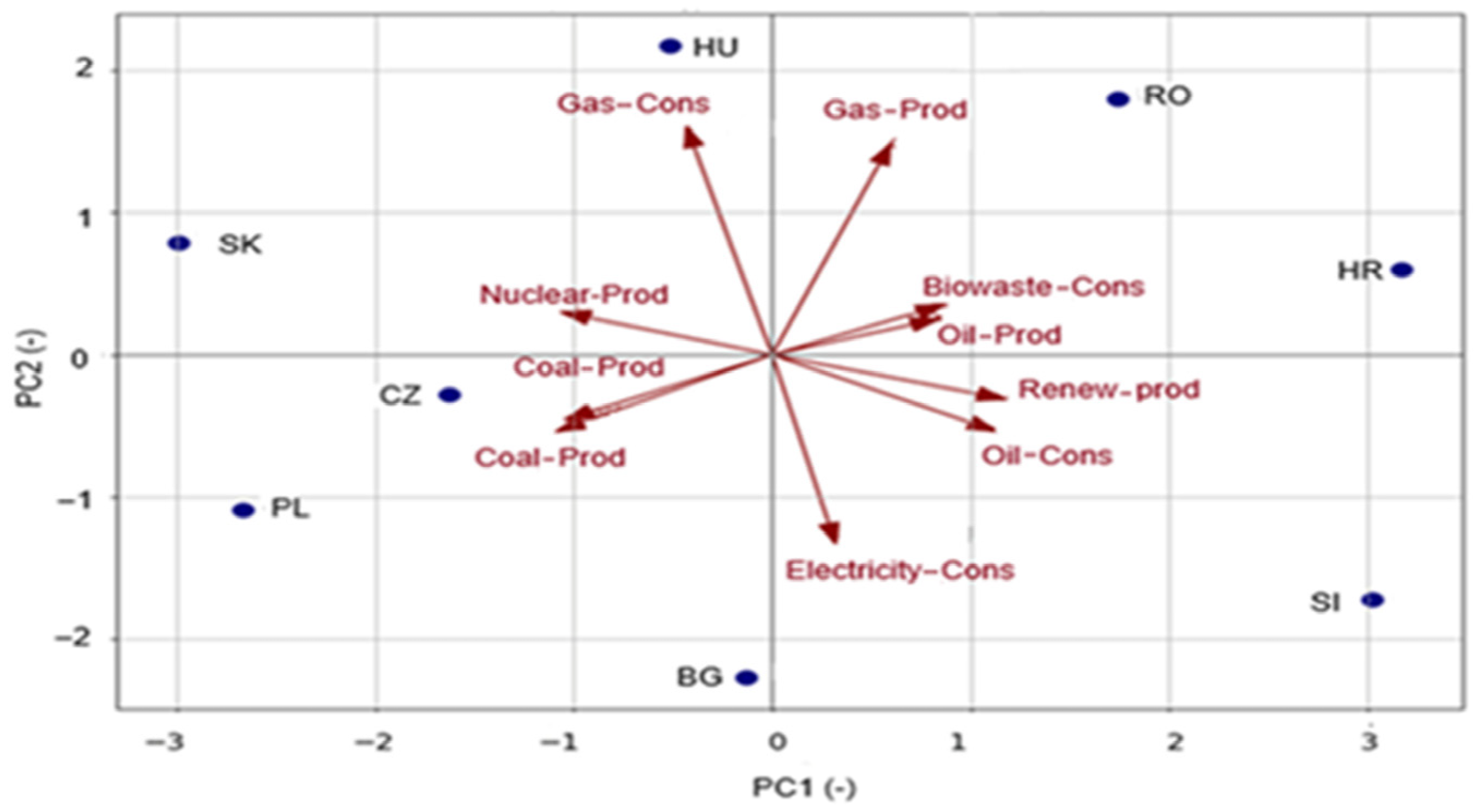
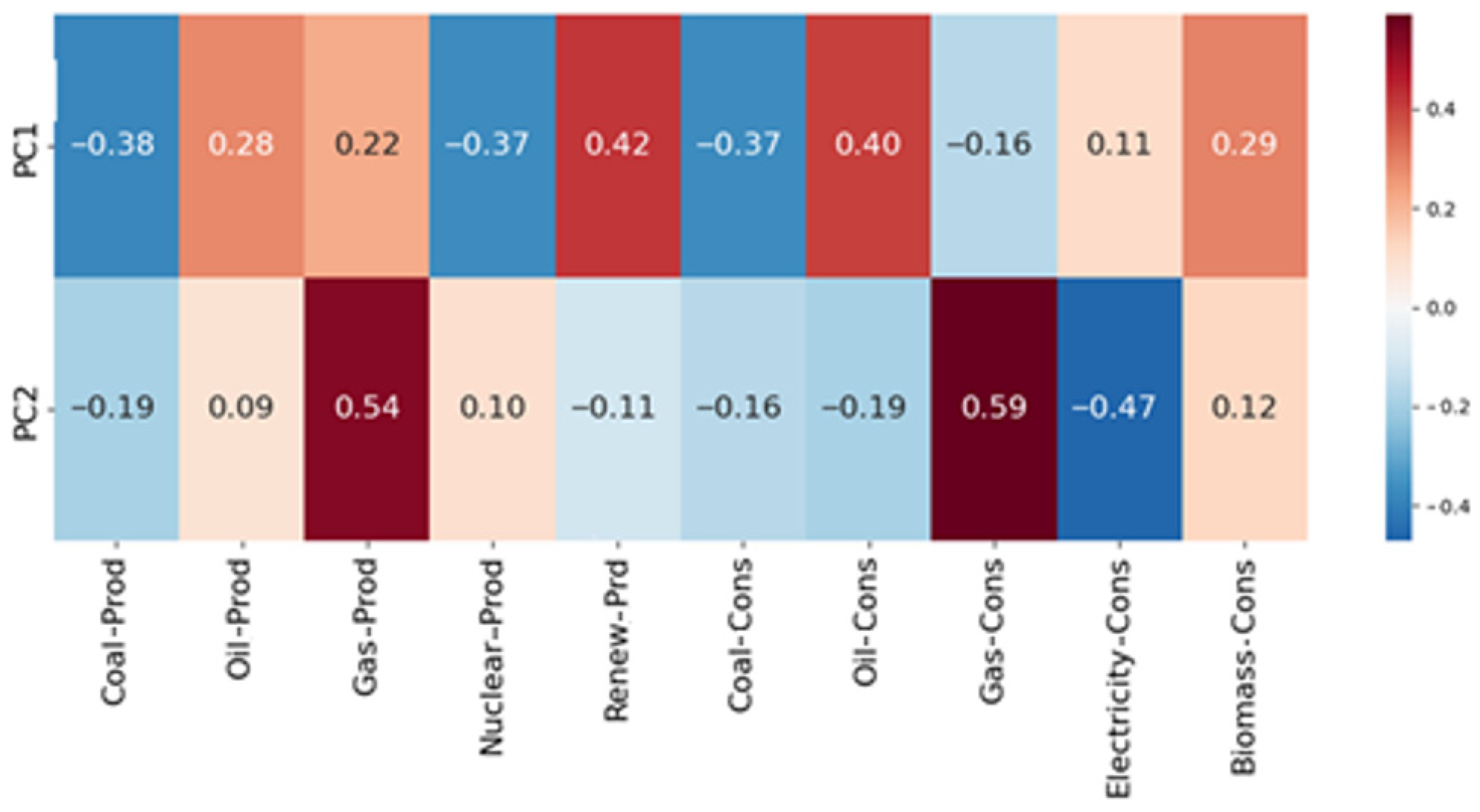
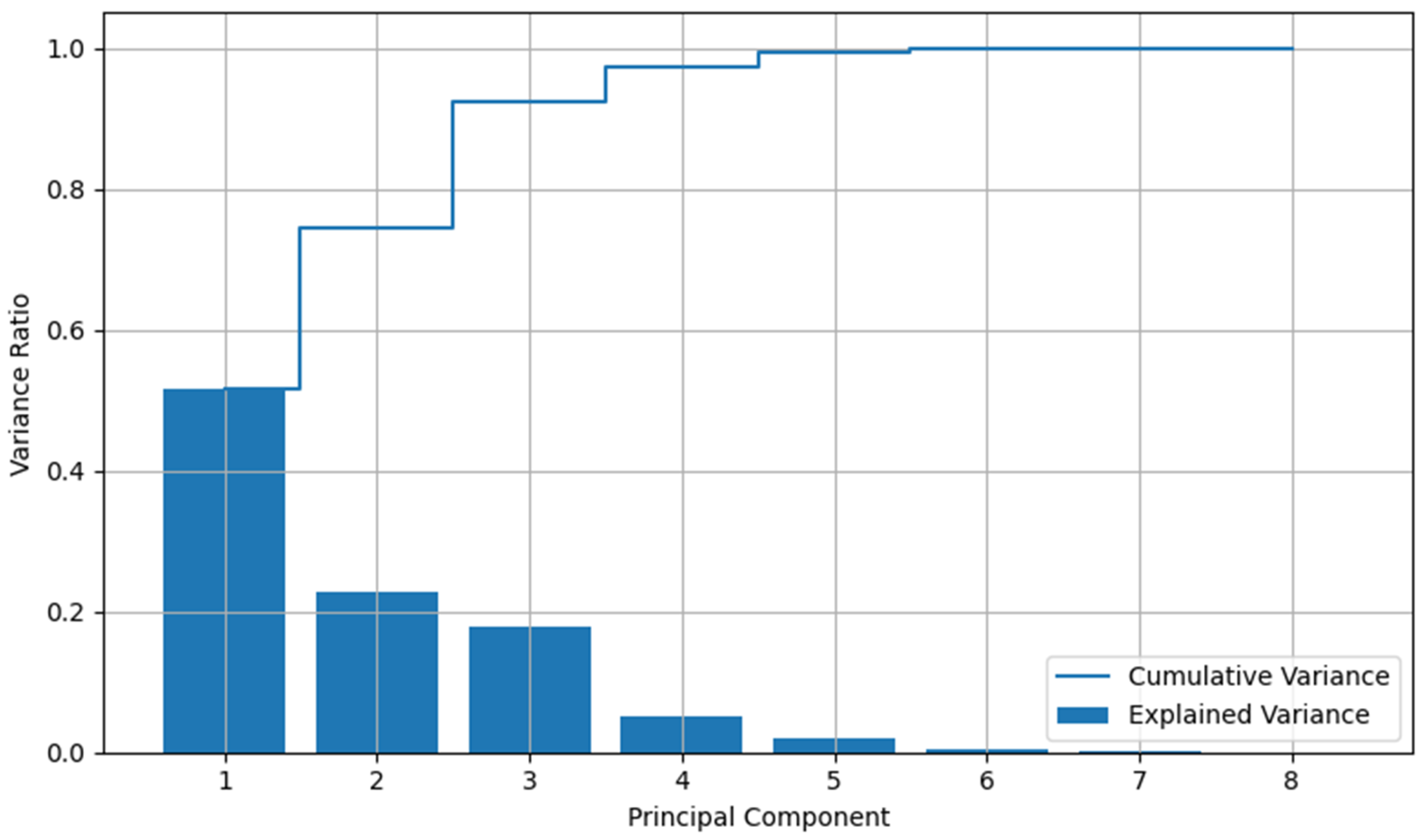
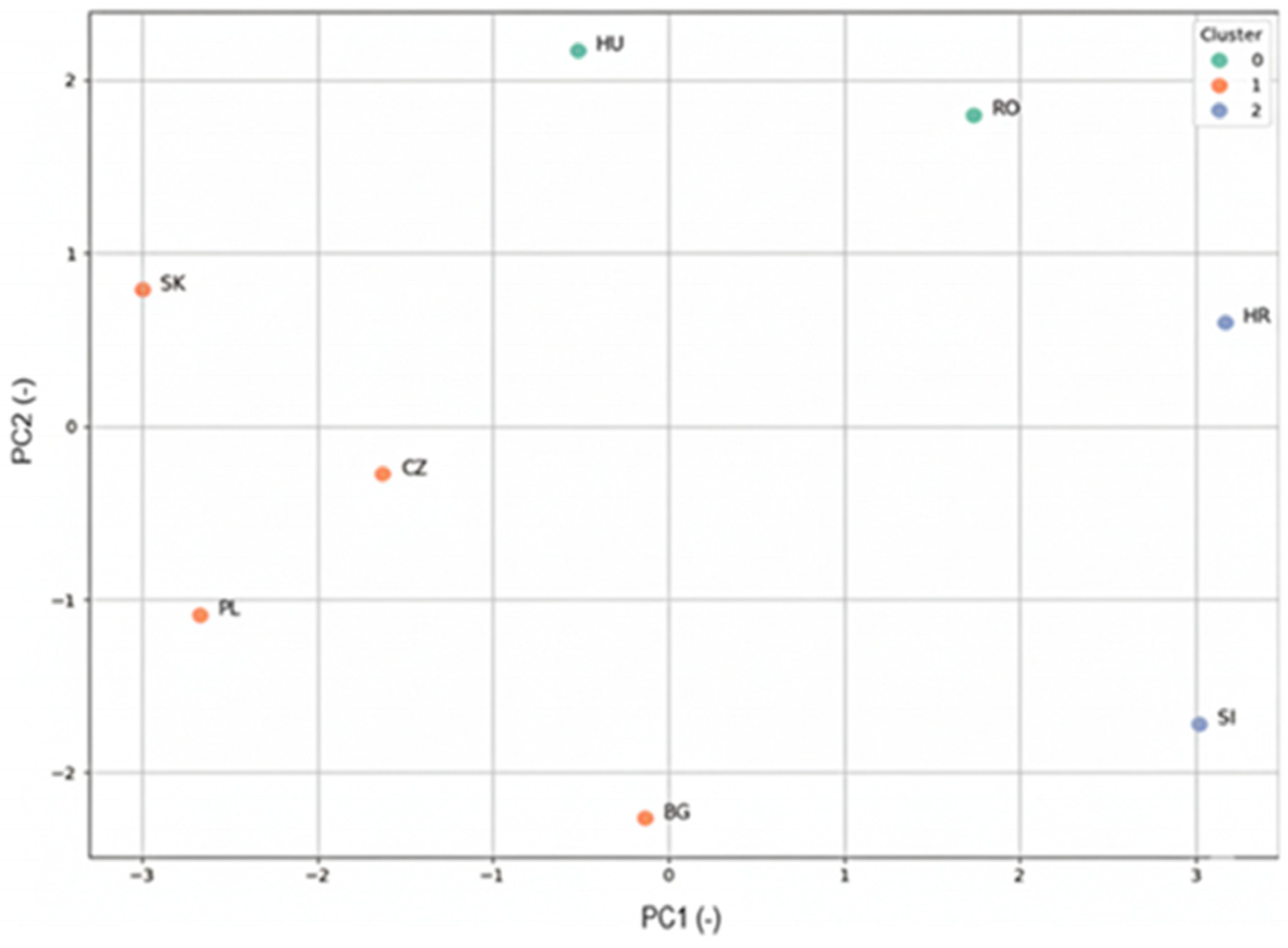
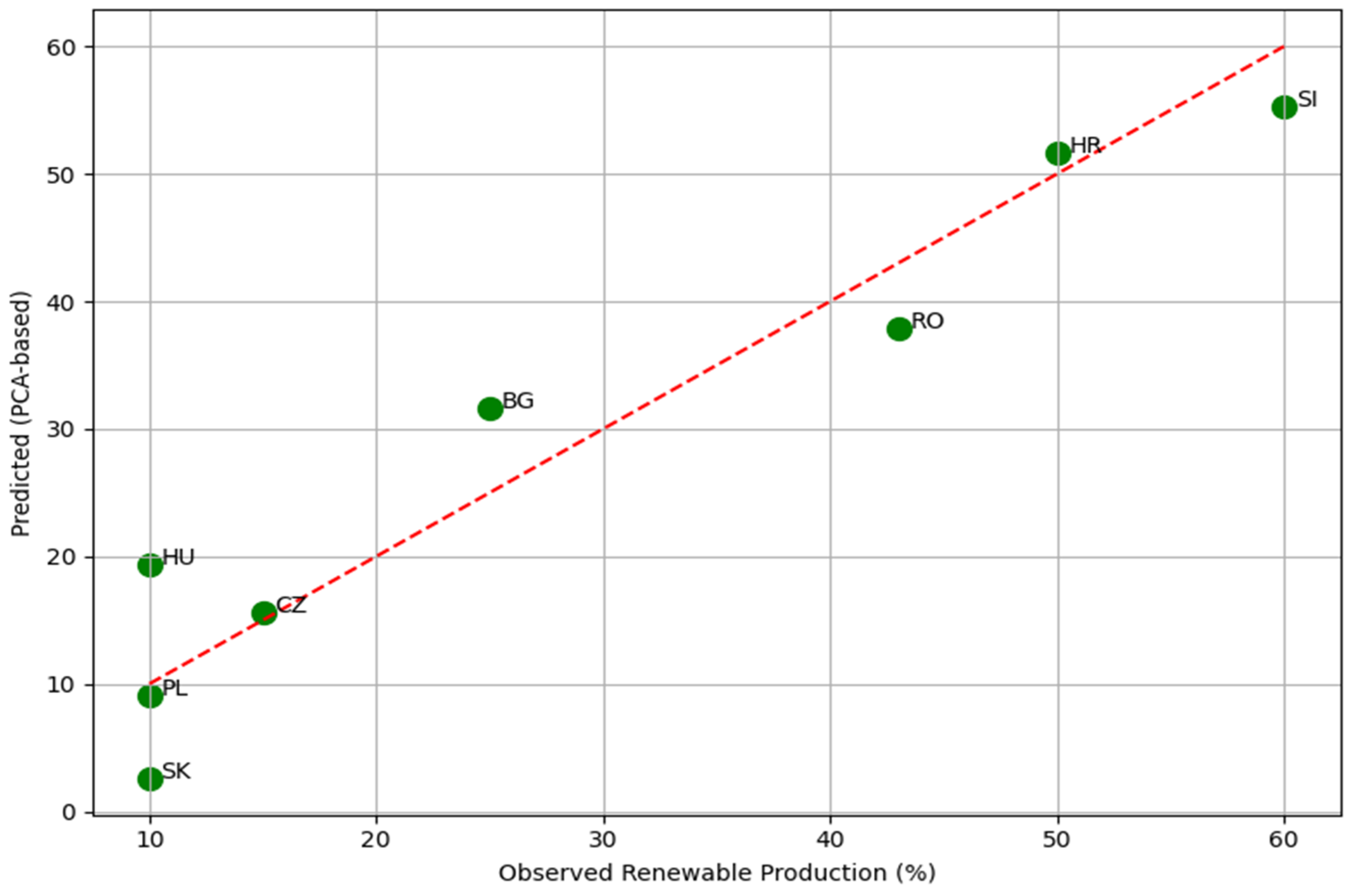
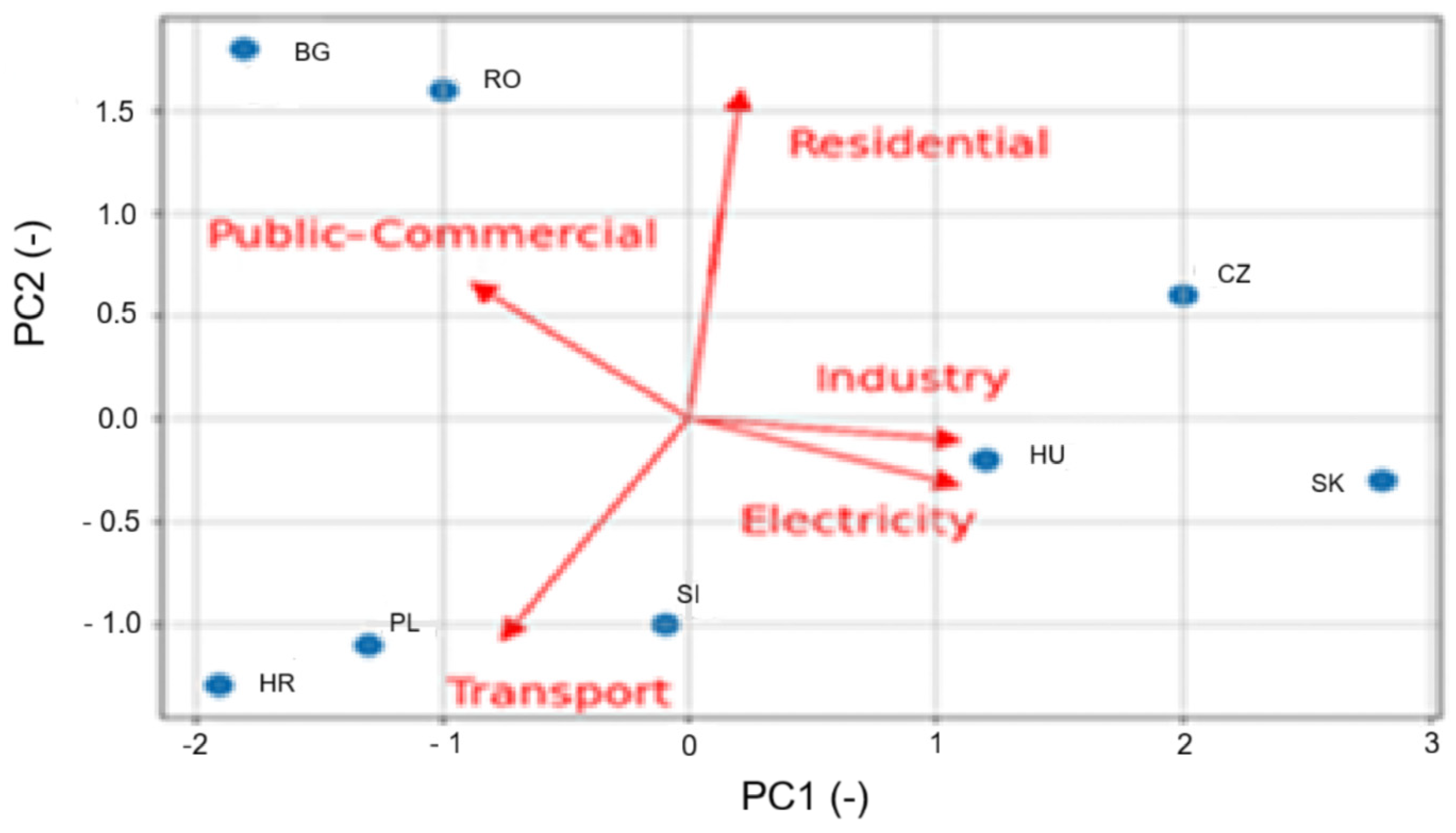
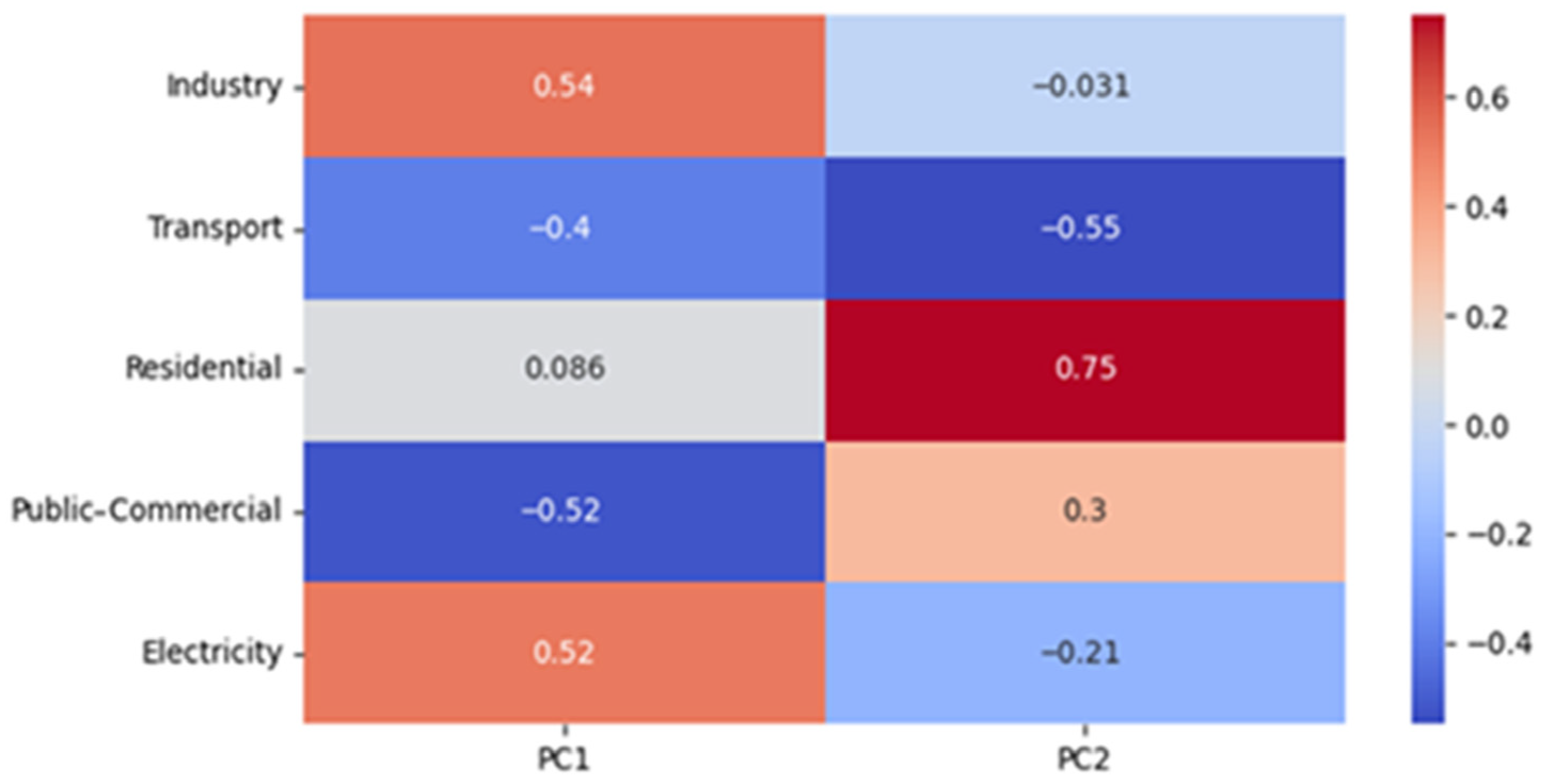
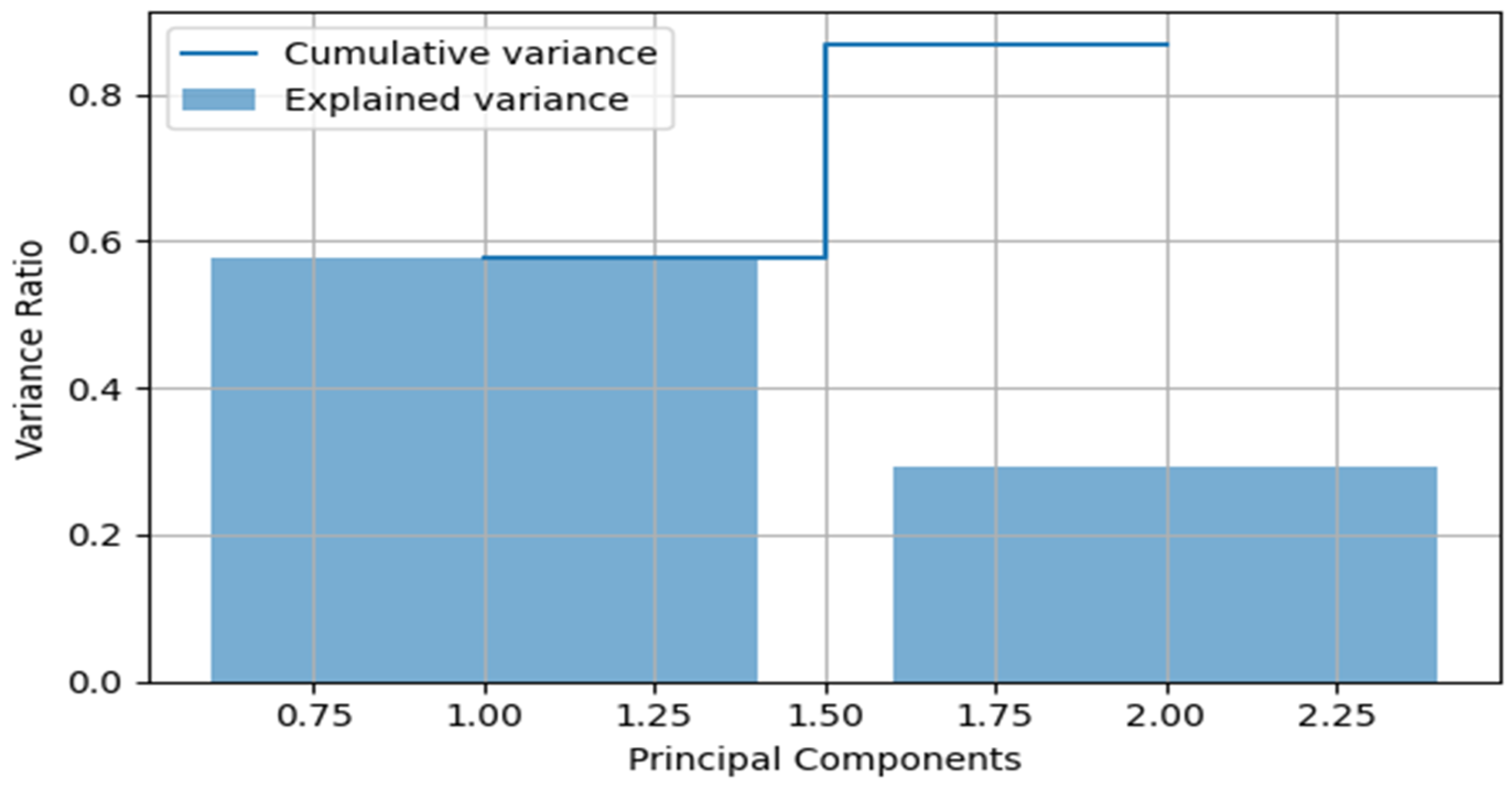

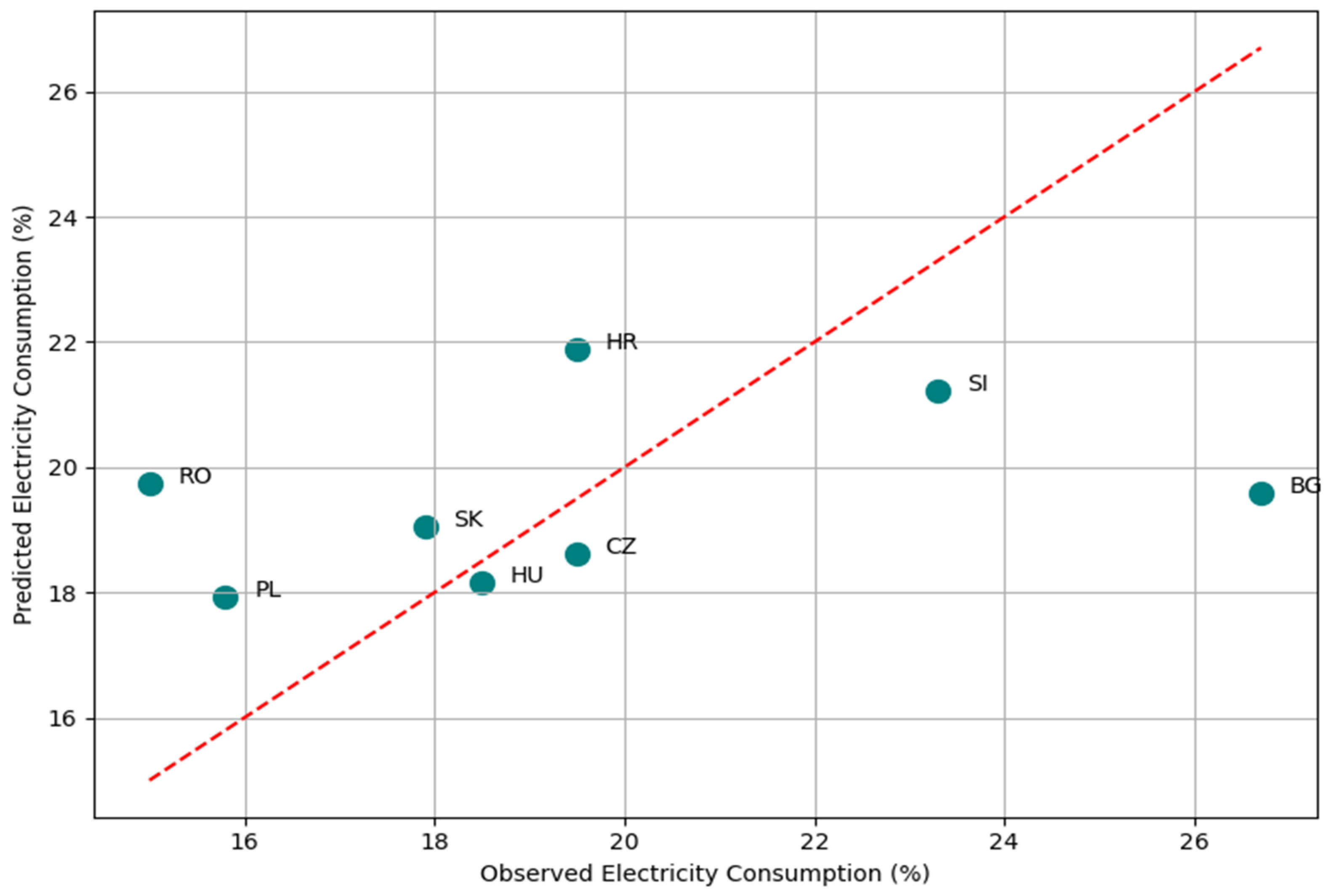
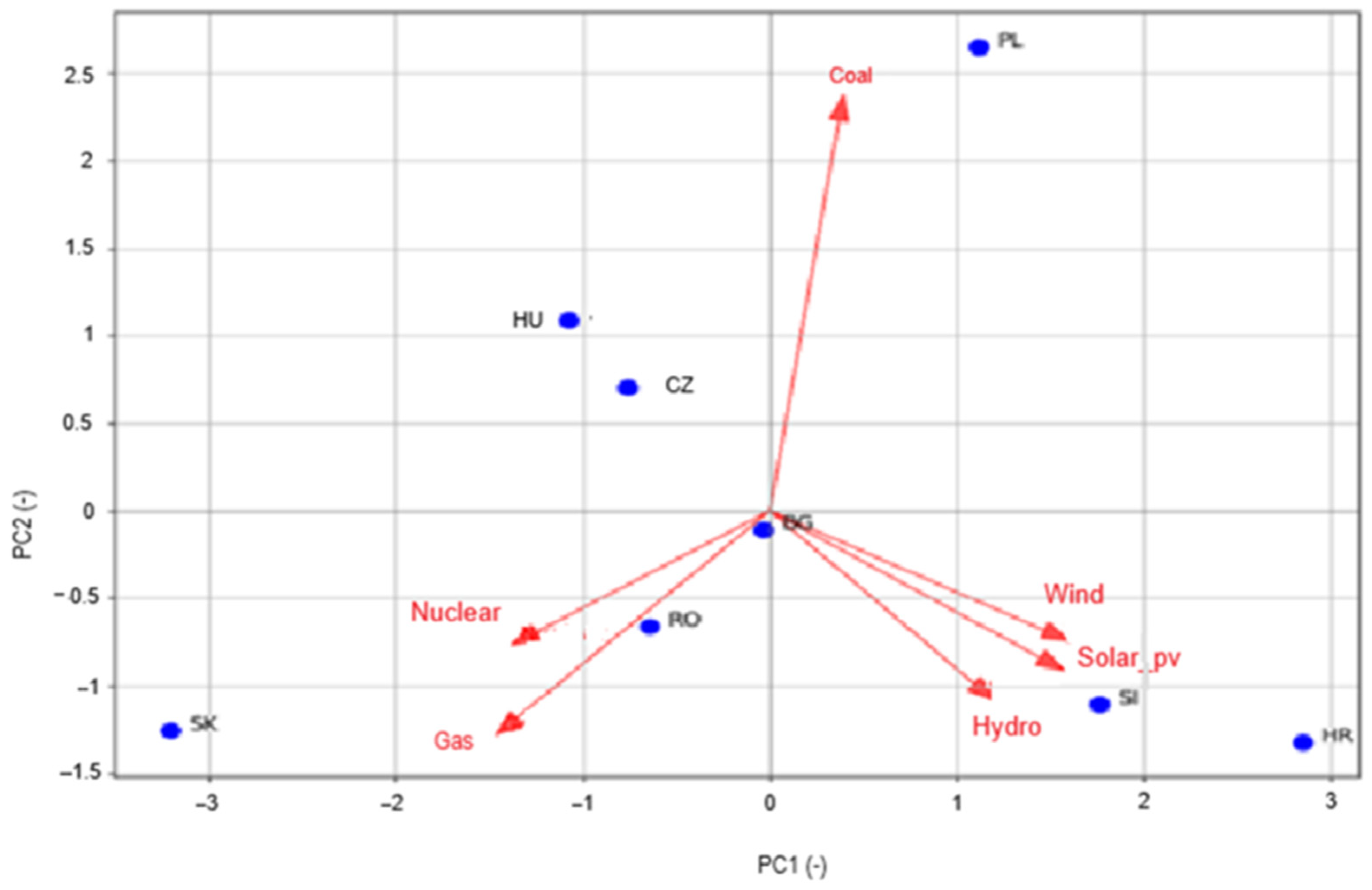

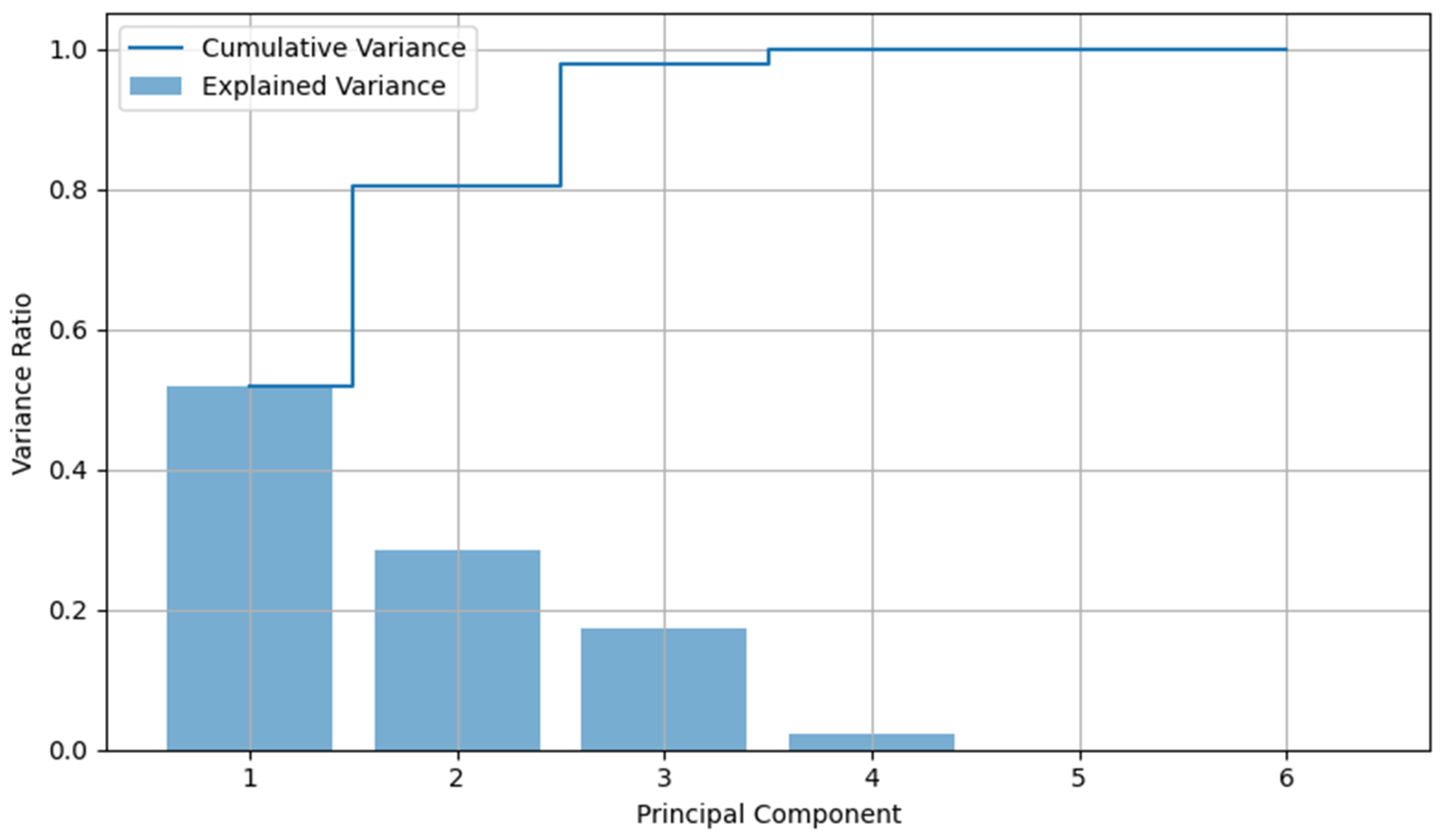

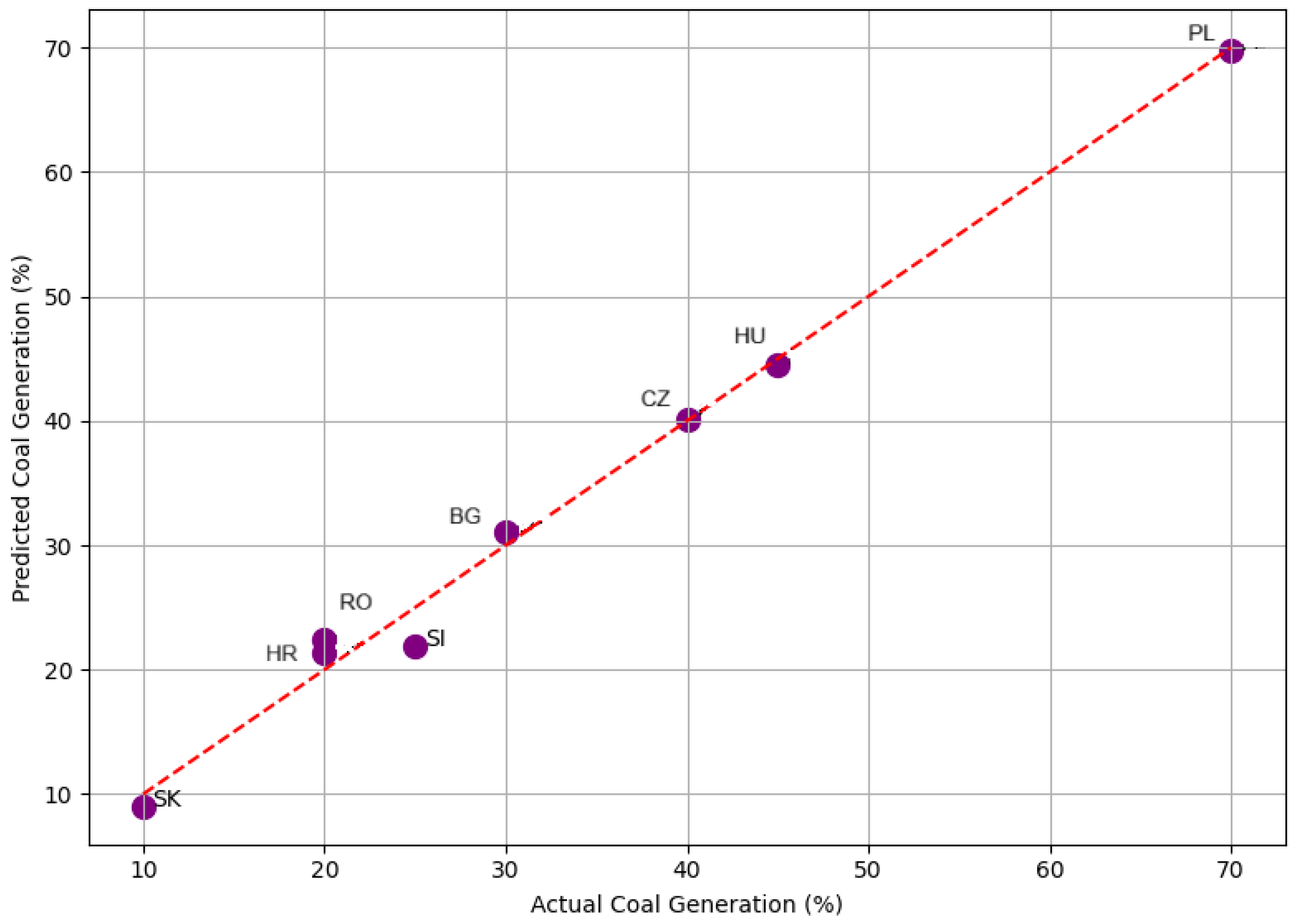
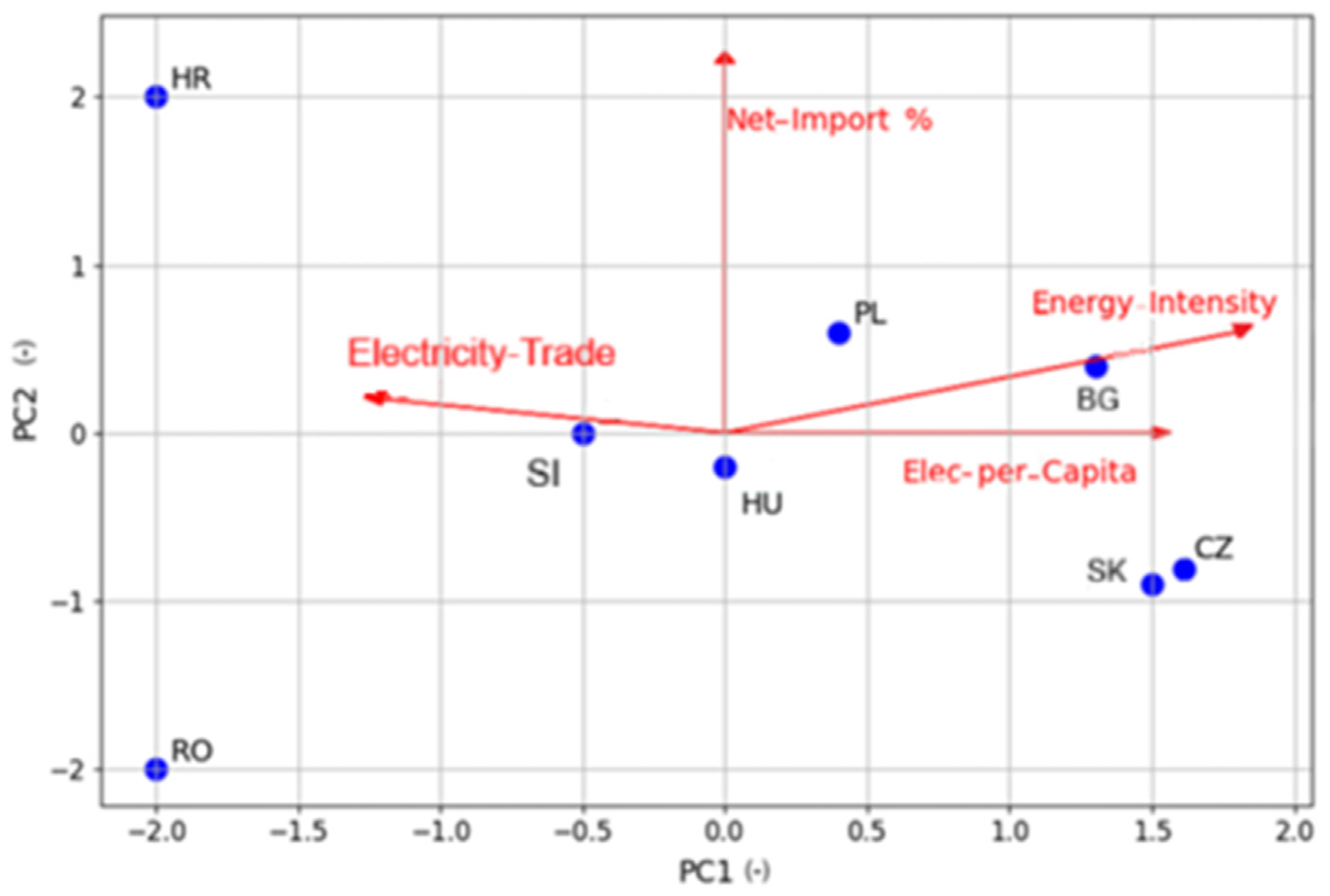


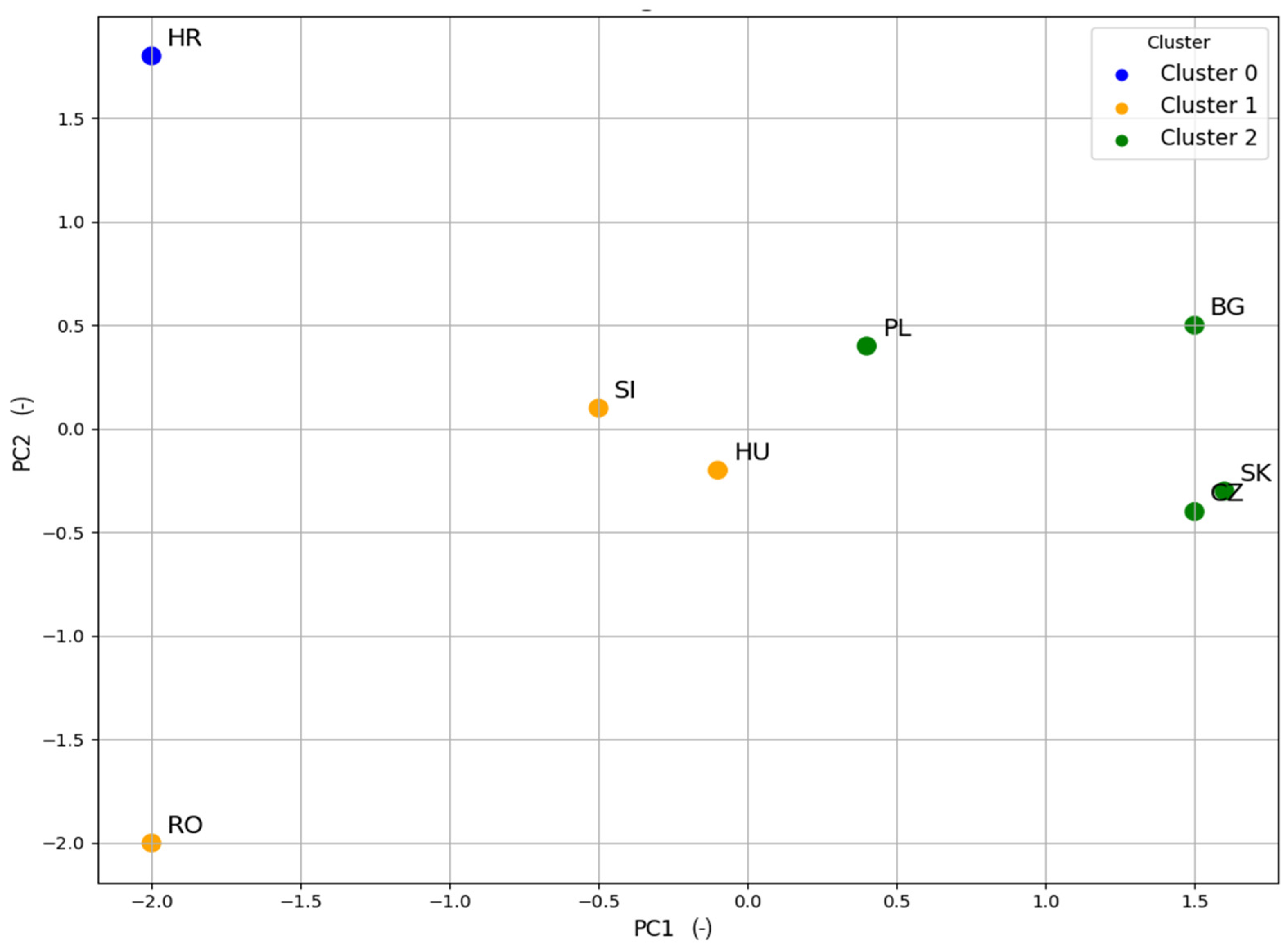
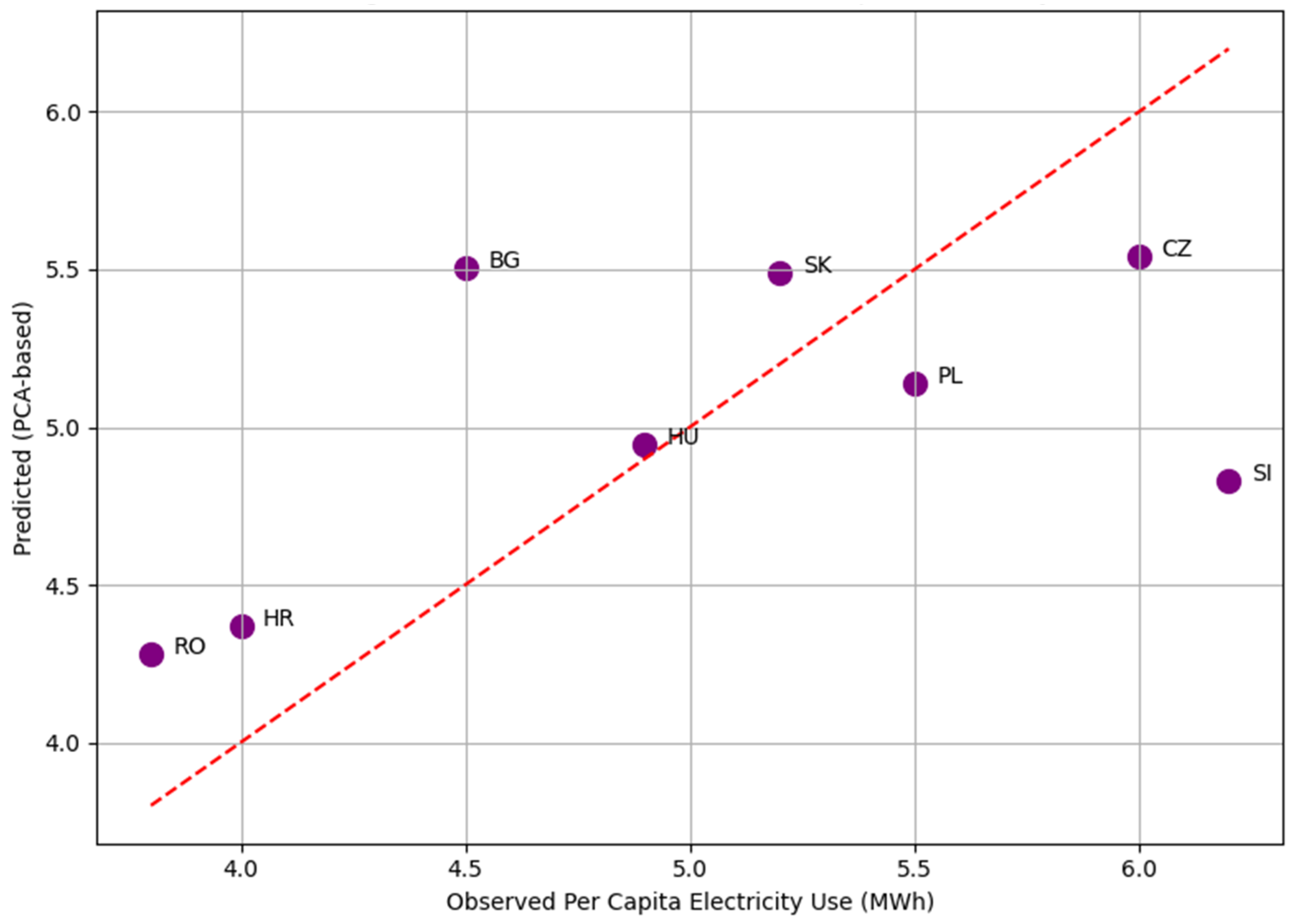

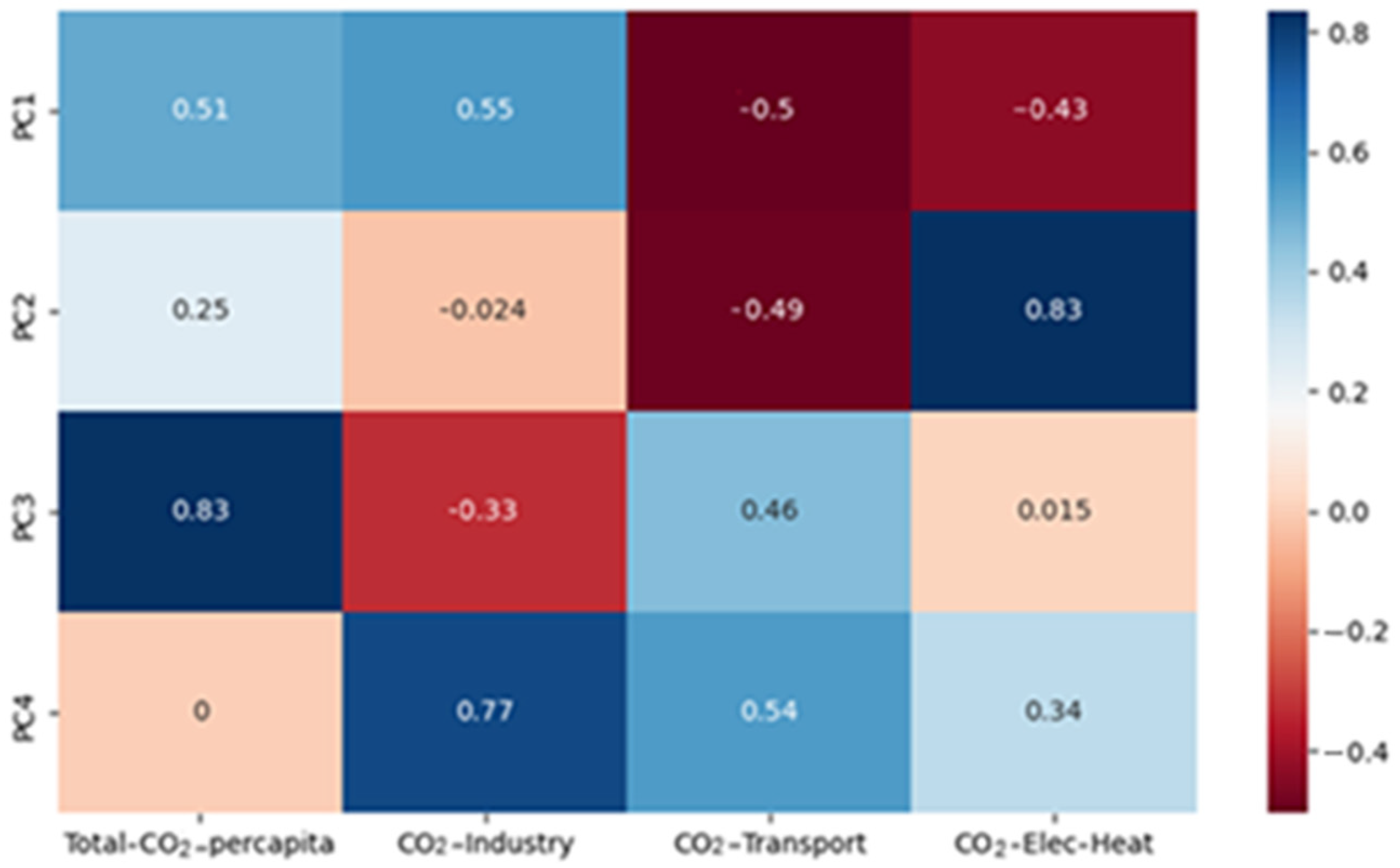
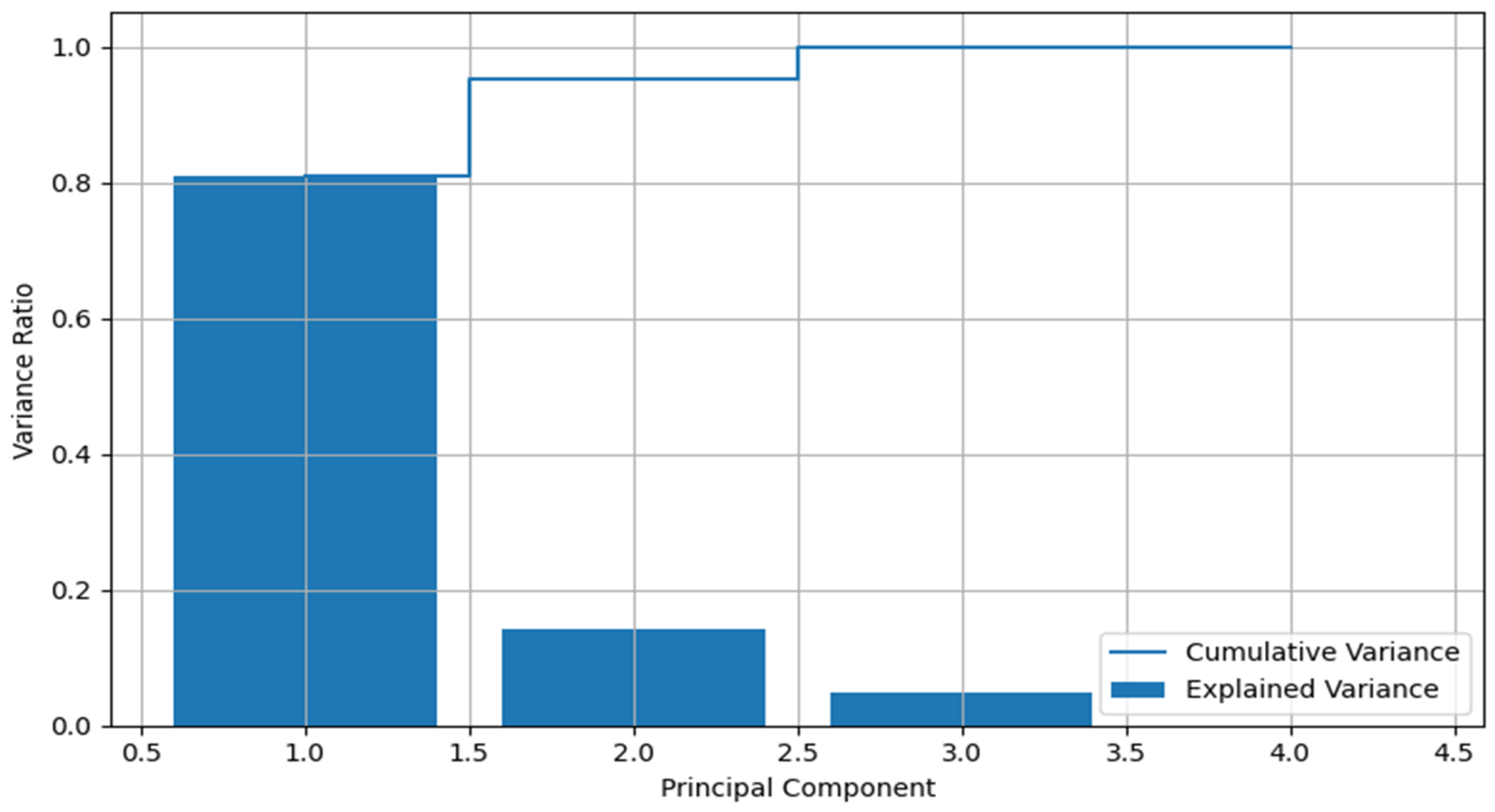
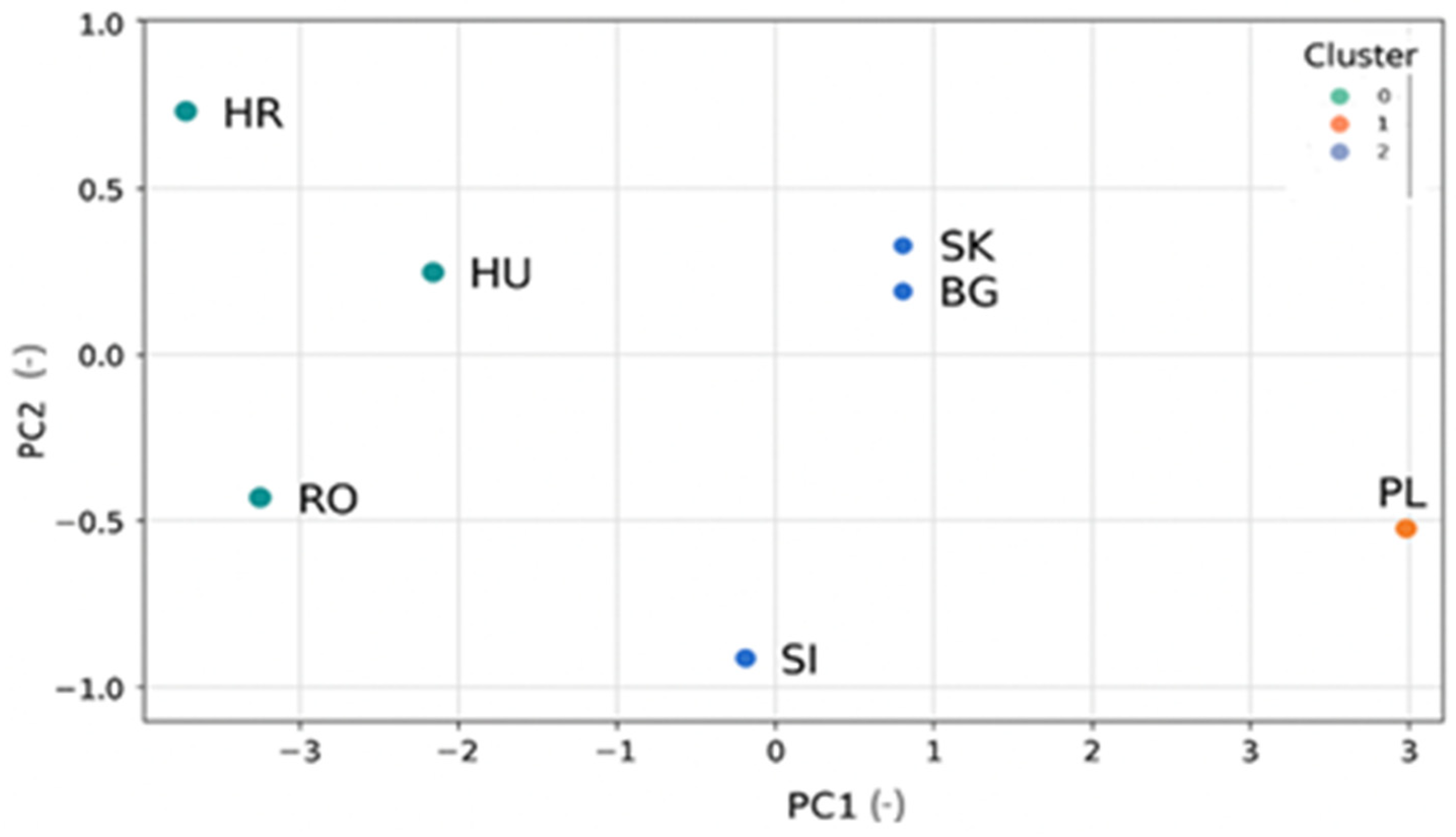
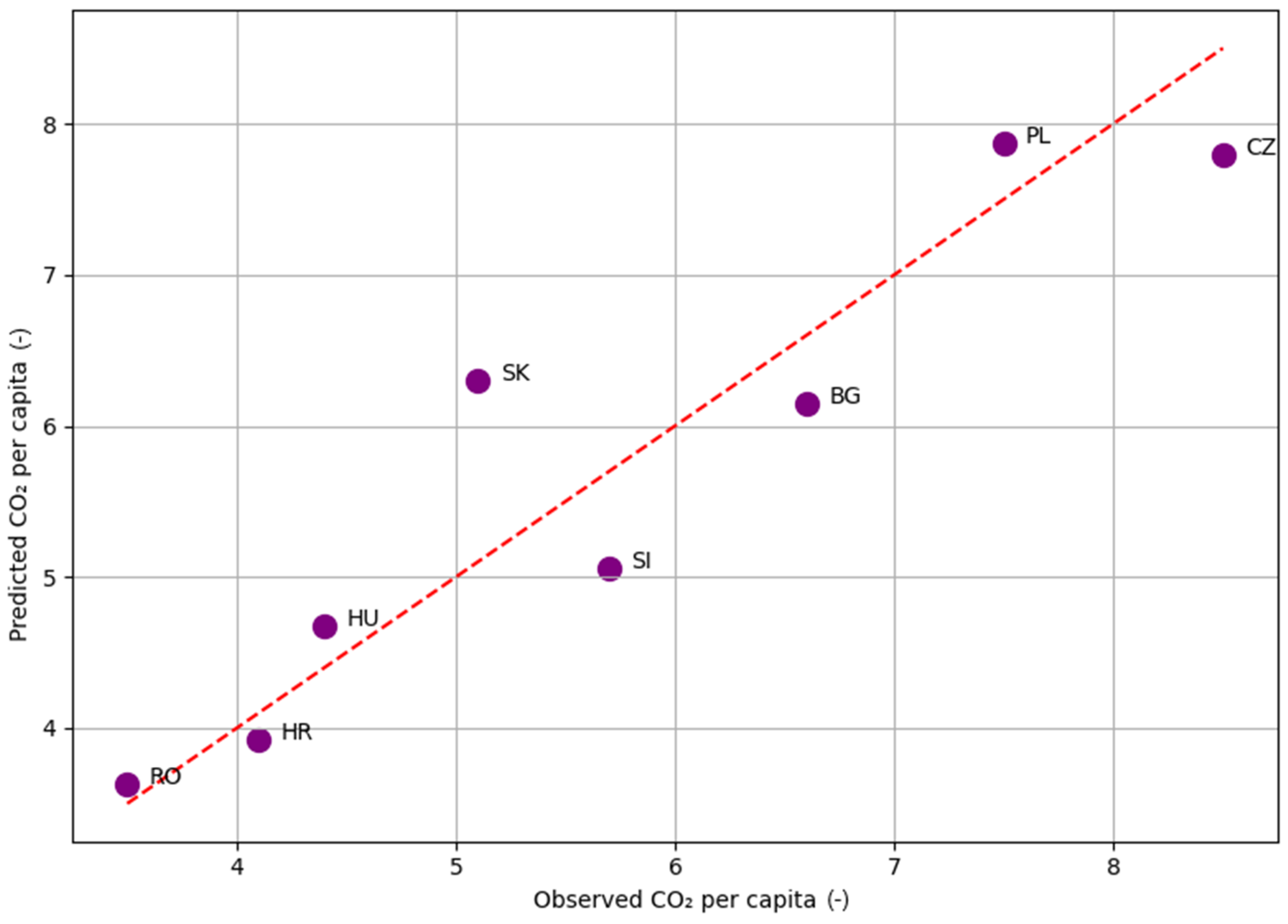
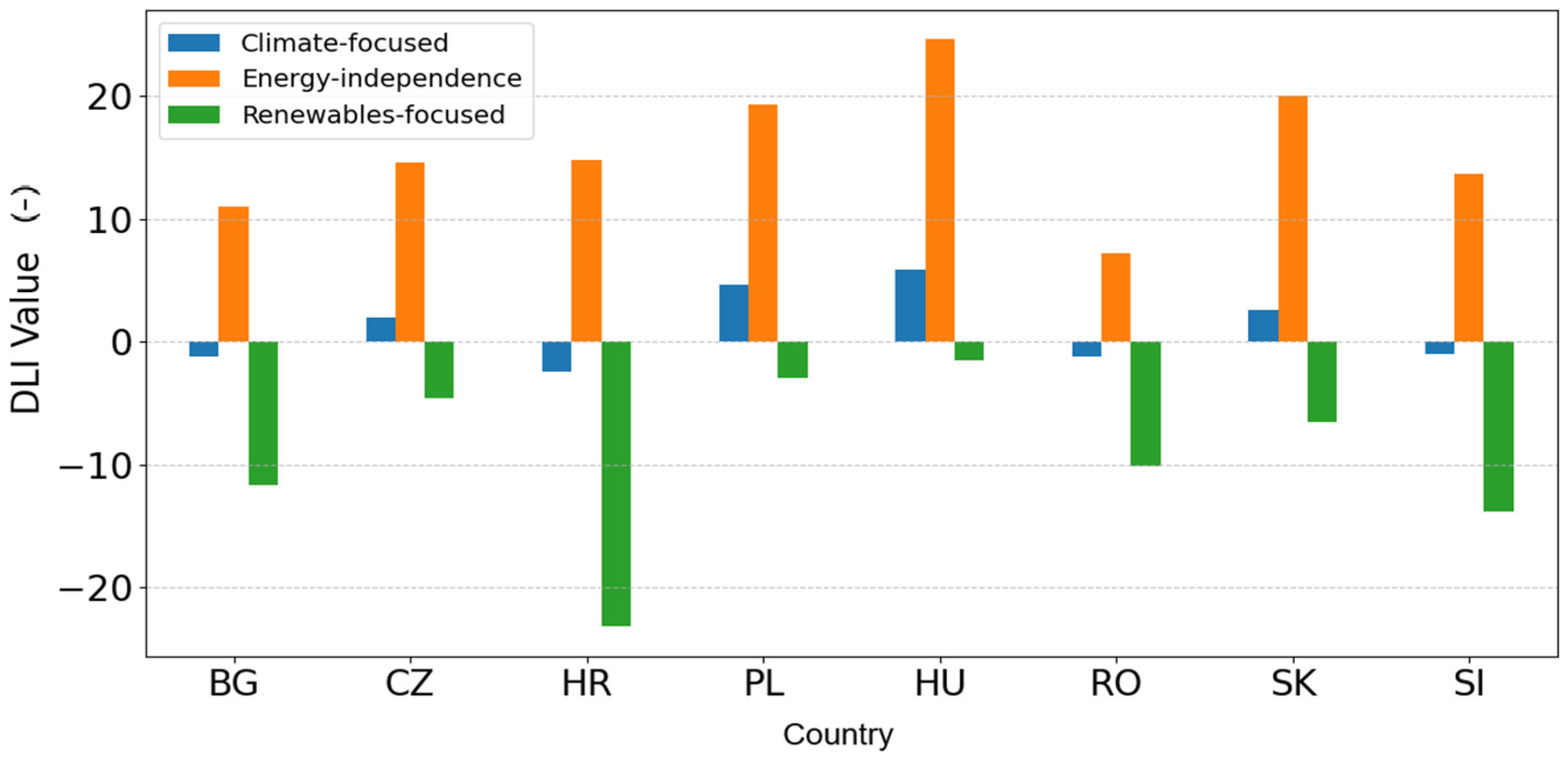

| Dependent Variable | Renewable production | R-squared | 0.918 | ||||||||||||||||||||||||
| Model | OLS | Adjusted R-squared | 0.885 | ||||||||||||||||||||||||
| Method | Least Squares | F-statistic | 27.97 | ||||||||||||||||||||||||
| No observations | 8 | Probability (F-statistic) | 0.00193 | ||||||||||||||||||||||||
| Degrees of Freedom Residuals | 5 | Log-likelihood | −24.898 | ||||||||||||||||||||||||
| Degrees of Fredoom Model | 2 | AIC | 55.80 | ||||||||||||||||||||||||
| Covariance Type | Nonrobust | BIC | 56.03 | ||||||||||||||||||||||||
| - | Coefficient | Standard error | T | 0.025 | 0.975 | ||||||||||||||||||||||
| Constant | 27.8750 | 2.432 | 11.464 | 0.000 | 21.624 | 34.126 | |||||||||||||||||||||
| X1 | 7.8888 | 31.071 | 0.254 | 0.001 | 5.136 | 10.642 | |||||||||||||||||||||
| X2 | −2.0911 | 1.609 | −1.300 | 0.250 | −6.226 | 2.044 | |||||||||||||||||||||
| Omnibus | 0.583 | Durbin-Watson | 1.555 | ||||||||||||||||||||||||
| Probability (Omnibus) | 0.747 | Jarque–Bera (JB) | 0.541 | ||||||||||||||||||||||||
| Skew | −0.346 | Probability JB | 0.763 | ||||||||||||||||||||||||
| Kurtosis | 1.931 | Condition number | 2.27 | ||||||||||||||||||||||||
| Dependent Variable | Electricity | R-squared | 0.841 | ||||||||||||||||||||||||
| Model | OLS | Adjusted R-squared | 0.778 | ||||||||||||||||||||||||
| Method | Least Squares | F-statistic | 13.26 | ||||||||||||||||||||||||
| No observations | 8 | Probability (F-statistic) | 0.010 | ||||||||||||||||||||||||
| Degrees of Freedom Residuals | 5 | Log-likelihood | −8.9967 | ||||||||||||||||||||||||
| Degrees of Freedom Model | 2 | AIC | 23.99 | ||||||||||||||||||||||||
| Covariance Type | Nonrobust | BIC | 24.23 | ||||||||||||||||||||||||
| - | Coefficient | Standard error | T | 0.025 | 0.975 | ||||||||||||||||||||||
| Constant | 38.00 | 0.333 | 114.052 | 0.00 | 37.144 | 38.856 | |||||||||||||||||||||
| X1 | 0.9724 | 0.196 | 4.955 | 0.004 | 0.468 | 1.477 | |||||||||||||||||||||
| X2 | −0.3879 | 0.276 | −1.406 | 0.219 | −1.097 | 0.321 | |||||||||||||||||||||
| Omnibus | 0.735 | Durbin-Watson | 2.536 | ||||||||||||||||||||||||
| Probability (Omnibus) | 0.692 | Jarque–Bera (JB) | 0.110 | ||||||||||||||||||||||||
| Skew | 0.259 | Probability JB | 0.947 | ||||||||||||||||||||||||
| Kurtosis | 2.754 | Condition Number | 1.70 | ||||||||||||||||||||||||
| Dependent Variable | Coal | R-squared | 0.992 | ||||||||||||||||||||||||
| Model | OLS | Adjusted R-squared | 0.989 | ||||||||||||||||||||||||
| Method | Least Squares | F-statistic | 303.6 | ||||||||||||||||||||||||
| No observations | 8 | Probability (F-statistic) | 6.03 × 10−6 | ||||||||||||||||||||||||
| Degrees of Freedom Residuals | 5 | Log-likelihood | −15.1 | ||||||||||||||||||||||||
| Degrees of Freedom Model | 2 | AIC | 36.20 | ||||||||||||||||||||||||
| Covariance Type | Nonrobust | BIC | 36.44 | ||||||||||||||||||||||||
| - | Coefficient | Standard error | T | 0.025 | 0.975 | ||||||||||||||||||||||
| Constant | 32.5 | 0.715 | 45.486 | 0.00 | 30.663 | 34.337 | |||||||||||||||||||||
| X1 | 2.1766 | 0.405 | 5.374 | 0.003 | 1.135 | 3.218 | |||||||||||||||||||||
| X2 | 13.1412 | 0.546 | 24.047 | 0.001 | 11.736 | 14.546 | |||||||||||||||||||||
| Omnibus | 1.102 | Durbin-Watson | 1.519 | ||||||||||||||||||||||||
| Probability (Omnibus) | 0.576 | Jarque–Bera (JB) | 0.273 | ||||||||||||||||||||||||
| Skew | 0.437 | Probability JB | 0.873 | ||||||||||||||||||||||||
| Kurtosis | 2.765 | Condition number | 1.76 | ||||||||||||||||||||||||
| Dependent Variable | Elec/per capita | R-squared | 0.324 | ||||||||||||||||||||||||
| Model | OLS | Adjusted R-squared | 0.058 | ||||||||||||||||||||||||
| Method | Least Squares | F-statistic | 1.196 | ||||||||||||||||||||||||
| No observations | 8 | Probability (F-statistic) | 0.376 | ||||||||||||||||||||||||
| Degrees of Freedom Residuals | 5 | Log-likelihood | −8.2363 | ||||||||||||||||||||||||
| Degrees of Freedom Model | 2 | AIC | 22.47 | ||||||||||||||||||||||||
| Covariance Type | Nonrobust | BIC | 22.71 | ||||||||||||||||||||||||
| - | Coefficients | Standard error | T | 0.025 | 0.975 | ||||||||||||||||||||||
| Constant | 5.0125 | 0.303 | 16.545 | 0.00 | 4.234 | 5.791 | |||||||||||||||||||||
| X1 | 0.3381 | 0.219 | 1.545 | 0.183 | −0.225 | 0.901 | |||||||||||||||||||||
| X2 | 0.0250 | 0.297 | 0.084 | 0.936 | −0.739 | 0.789 | |||||||||||||||||||||
| Omnibus | 1.598 | Durbin-Watson | 1.769 | ||||||||||||||||||||||||
| Probability (Omnibus) | 0.450 | Jarque–Bera (JB) | 0.508 | ||||||||||||||||||||||||
| Skew | 0.606 | Probability JB | 0.776 | ||||||||||||||||||||||||
| Kurtosis | 2.766 | Condition Number | 1.38 | ||||||||||||||||||||||||
| Dependent Variable | Total CO2 per capita | R-squared | 0.869 | ||||||||||||||||||||||||
| Model | OLS | Adjusted R-squared | 0.817 | ||||||||||||||||||||||||
| Method | Least Squares | F-statistic | 16.59 | ||||||||||||||||||||||||
| No observations | 8 | Probability (F-statistic) | 0.00620 | ||||||||||||||||||||||||
| Degrees of Freedom Residuals | 5 | Log-likelihood | −7.1432 | ||||||||||||||||||||||||
| Degrees of Freedom Model | 2 | AIC | 20.29 | ||||||||||||||||||||||||
| Covariance Type | Nonrobust | BIC | 20.52 | ||||||||||||||||||||||||
| - | Coefficient | Standard error | T | 0.025 | 0.975 | ||||||||||||||||||||||
| Constant | 5.6750 | 0.264 | 21.474 | 0.00 | 4.996 | 6.354 | |||||||||||||||||||||
| X1 | 0.8286 | 0.147 | 5.643 | 0.002 | 0.451 | 1.206 | |||||||||||||||||||||
| X2 | 0.4054 | 0.351 | 1.156 | 0.300 | −0.496 | 1.306 | |||||||||||||||||||||
| Omnibus | 1.491 | Durbin-Watson | 1.857 | ||||||||||||||||||||||||
| Probability (Omnibus) | 0.474 | Jarque–Bera (JB) | 0.626 | ||||||||||||||||||||||||
| Skew | −0.655 | Probability JB | 0.731 | ||||||||||||||||||||||||
| Kurtosis | 2.596 | Condition Number | 2.39 | ||||||||||||||||||||||||
| Country | Area | Planned Change | Expected Annual Energy Change (TWh) | Expected Annual CO2 Savings (Mt/year) | Notes/Related Programs and Strategies |
|---|---|---|---|---|---|
| Hungary [35,36,37,38,39] | Nuclear capacity expansion | Paks II (2 × 1200 MW) | +18.9 | 3.78 | Paks II project, 2022–2030 implementation |
| Renewable energy | Solar PV growth (8 Gigawatt (GW) total) | +6–8 | 1.2–1.6 | METÁR program, solar subsidies | |
| Coal phase-out | Closure of Mátra coal plant | −1–2 | 0.5–1 | Coal exit strategy 2025 | |
| Energy efficiency | Renovation buildings | −2–3 | 0.8–1.2 | National Renovation Program | |
| Slovakia [40,41,42] | Nuclear capacity expansion | Mochovce 3–4 (~940 MW each) | +18.9 | 3.78 | Mochovce Nuclear Power Plant (NPP) expansion |
| Renewable energy | Solar/wind expansion | +4–6 | 0.8–1.2 | Slovak Renewable Energy Sources (RES) Support Scheme | |
| Coal phase-out | Phase-out by 2023 | −4.0 | 1.2 | Government Resolution 2019 | |
| Energy efficiency | Renovation buildings | −2 | 0.7 | National Renovation Program | |
| Czech Republic [43,44] | Nuclear capacity expansion | Dukovany new block (1200 MW) | +8.7 | 4.21 | Dukovany NPP tender |
| Renewable energy | Solar/wind | +5.0 | 1.5 | Modernisation Fund | |
| Coal phase-out | Gradual 2033 exit | −10.0 | 7.0 | Coal Commission | |
| Energy efficiency | Renovation buildings | −3 | 1–1.5 | National Renovation Program | |
| Poland [45,46] | Nuclear capacity expansion | 6–9 GW by 2033 (partial by 2030 ~3 GW) | +50–70 | 23.7–35.5 | Polish Nuclear Power Program (PPEJ) |
| Renewable energy | Wind offshore/onshore, solar | +15–20 | 5–7 | PSE2040; RES auctions | |
| Coal phase-out | Gradual reduction | −30–35 | 20–25 | Coal sector restructuring | |
| Energy efficiency | Renovation buildings | −7–9 | 3–4 | National Renovation Program | |
| Romania [47,48] | Nuclear capacity expansion | Cernavodă Units 3–4 (~1400 MW) | +11 | 3.31 | Cernavodă expansion |
| Renewable energy | Wind/solar | +7–9 | 5–7 | Green Transition Fund | |
| Coal phase-out | reduction in coal production | −4–6 | 3–5 | Energy Ministry plan | |
| Energy efficiency | Renovation buildings | −2–3 | 1–2 | National Renovation Program | |
| Bulgaria [49,50] | Nuclear capacity expansion | Kozloduy Unit 7 (~1200 MW) | +18.1 | 6.35 | Kozloduy expansion |
| Renewable energy | Solar/wind/biomass | +5–7 | 2–3 | RES strategy 2030 | |
| Coal phase-out | reduction in coal production | −10–12 | 5–6 | Energy Ministry plan | |
| Energy efficiency | Renovation buildings | −2 | 0.8 | National Renovation Program | |
| Croatia [51,52] | Renewable energy | Solar/wind | +4–5 | 1–1.5 | RES strategy 2030 |
| Coal phase-out | reduction in coal production | −2 | 0.6 | Energy Ministry plan | |
| Energy efficiency | Renovation buildings | −1 | 0.4 | National Renovation Program | |
| Slovenia [53,54] | Nuclear capacity expansion | Krško 2 (~1200 MW) | +18.9 | 4.26 | Krško 2 feasibility |
| Renewable energy | Hydro, solar | +3–4 | 0.8–0.9 | Slovenian RES strategy | |
| Coal phase-out | phasing out coal | −3 | 1 | Energy Ministry plan | |
| Energy efficiency | Renovation buildings | −1 | 0.4 | National Renovation Program |
| Indicator | Value (TWh/Year) | Value (Mt CO2/Year) | Notes |
|---|---|---|---|
| Annual increase in nuclear production | +155.7–167.7 | 54.74–67.24 | Hungary, Slovakia, Czechia, Poland, Romania, Bulgaria, Slovenia—only planned new units |
| Annual increase in renewable production | +52–69 | 15.6–20.1 | Wind, solar, biomass, hydropower |
| Production decrease due to coal phase-out | −68–78 | 41.3–46.8 | Coal phase-out or significant reduction |
| Energy efficiency (savings) | −18–21 | 7.3–9.1 | Building and industrial efficiency programs |
| Energy storage and grid development | - | - | Batteries, smart grid developments |
| Country’s | Key Facts | Main Challenge | Recommendations | Fit with EU Packages |
|---|---|---|---|---|
| Bulgaria (BG) | Domestic production: large shares of nuclear (~41%) and coal (~34%). In all three scenarios, the DLI value is very low, indicating a favourable position. Electricity generation: substantial nuclear + coal share; emission profile elevated in power sector. | coal dependency in power despite domestic independence; elevated power-sector emissions. | Accelerate coal retirement with clear timelines and decommissioning plans; prioritise repurposing sites and workforce retraining (Just Transition-type measures). Scale variable renewables (utility PV and wind) and pair with storage and grid upgrades to balance nuclear baseload and replace coal. Upgrade grid flexibility (Demand Side Response (DSR), storage, interconnections) to integrate renewables while keeping nuclear contribution stable. Strengthen carbon-pricing pass-through and link revenues to investment in renewables and network modernisation. | Renewable Energy Directive (RED)-driven RES targets and Emissions Trading System (ETS) carbon price increases will make coal progressively less economic; access to Modernisation/Just Transition funds can finance plant closures and grid upgrades. |
| Czech Republic (CZ) | High domestic production including coal and nuclear; electricity generation shows balanced nuclear + coal. In all three scenarios, the DLI value is average, indicating vulnerability. | moving from coal while preserving electricity security; industrial emissions significant. | Use nuclear as transition backbone while rapidly expanding renewables in decentralised locations and adding storage. Industrial decarbonisation: promote electrification of processes, heat pumps for district heat where feasible, and pilots for low-carbon hydrogen for heavy industry. Improve energy efficiency in industry and buildings via targeted incentives and energy management programs. | ETS tightening and Carbon Border Adjustment Mechanism (CBAM) incentivise industry decarbonisation; RED and Energy Efficiency Directive (EED) obligations support renewables rollout and efficiency investments, with EU funds available for modernisation. |
| Croatia (HR) | Domestic production: relatively low coal, higher shares of oil/gas and renewables (hydro/wind). Final consumption: high oil share (transport), sizeable residential consumption. In all three scenarios, the DLI value is very low, indicating a favourable position. | heavy transport oil dependence; opportunities from renewables (hydro and growing wind/solar). | Transport electrification and rapid deployment of EV charging infrastructure; fiscal incentives to shift from oil-based road transport. Expand distributed solar (rooftops) and grid integration measures; utilise hydropower flexibility to backstop variable renewable output. Energy efficiency in buildings (renovation programmes) to reduce residential consumption. | Fit-for-55 supports transport electrification (CO2 standards) and RED targets boost renewables; access to Recovery/REPowerEU (EU plan to re-power Europe) funds can accelerate charging infrastructure and building renovation. |
| Poland (PL) | Very high coal share in domestic production (~66%) and electricity generation (≈60%); high absolute emissions. In all three scenarios, the DLI value is very high, indicating significant vulnerability. | deepest structural coal dependence, large emissions, social and economic complexity of transition. | Immediate and credible coal phase-out plan with social transition packages (jobs, retraining, regional development). Fast-track large-scale renewables (onshore/offshore) + storage and grid reinforcement. Leverage planned nuclear capacity as baseload but ensure sequencing of renewables and storage to replace coal. Scale energy efficiency retrofits nationwide (residential + public buildings) for demand reduction. | ETS and carbon pricing and higher 2030 targets increase pressure to decarbonise; Just Transition Fund and Modernisation Fund should be mobilised to finance regional shifts away from coal. |
| Hungary (HU) | Significant nuclear share in electricity (domestic nuclear ~38.7%, generation nuclear ~44.8%); considerable gas and oil in other sectors; relatively high import dependency. In all three scenarios, the DLI value is very high, indicating significant vulnerability. | Import dependence for some fuels; need for diversification and stronger RES rollout. | Proceed with safe nuclear completion (if continuing) while diversifying supply—balance Paks II with accelerated renewables (large-scale PV) and storage. Reduce gas/oil dependence in buildings and transport via efficiency programmes and electrification. Enhance energy security by diversifying gas supply routes, increasing interconnectivity, and strategic storage. | Nuclear contributes to security while RED/EED drive renewables and efficiency; ETS increases incentive to cut fossil fuel use in heating and industry. |
| Romania (RO) | Domestic production mix: notable natural gas and hydro; some nuclear (existing Cernavodă) and renewable potential. In all three scenarios, the DLI value is low, indicating lower vulnerability. | Modernising gas sector and scaling variable renewables while preserving hydropower resources. | Scale wind and solar in high-resource regions and exploit grid-forming hydropower flexibility. Advance Cernavodă expansion cautiously (if pursued) alongside renewables to minimise emissions. Prioritise energy efficiency in buildings and industry, given already favourable energy intensity. | Funding for Renewable Energy Deployment FRED/REPowerEU support large-scale renewables; Fit-for-55 and ETS reform shape gas-to-renewables economics; funding instruments (Green Transition Fund) are directly relevant. |
| Slovakia (SK) | Very high domestic nuclear share (domestic production ~65% and electricity generation nuclear ~61.3%); lower fossil shares. Moderate import dependency but exposure in some sectors. In all three scenarios, the DLI value is average, indicating vulnerability. | Integrating higher shares of renewables around strong nuclear baseload; addressing building/industrial efficiency. | Leverage nuclear as low-carbon base and invest in grid flexibility (storage, demand response) to integrate renewables. Promote electrification in transport and industry and targeted building retrofit programmes. Diversify energy supply where import exposure exists and increase interconnections. | Nuclear helps meet low-carbon targets; RED/EED and ETS push toward renewables and efficiency; Slovakia can benefit from EU support for grid and storage. |
| Slovenia (SI) | High share of nuclear and hydro in production; relatively high per capita electricity consumption and clean generation mix. In all three scenarios, the DLI value is low, indicating lower vulnerability. | Optimise use of hydro/nuclear flexibility, scale distributed renewables, and further reduce transport emissions. | Maximise renewable potential (solar + small hydro modernisation); use hydro as flexibility to integrate PV/wind. Electrify transport and decarbonise heating with heat pumps, plus continue building renovation programmes. Enhance regional market integration to export flexibility and benefit from market coupling. | Strong alignment—RED/EED measures enhance renewables and efficiency; electricity market reforms and cross-border integration under EU rules improve dispatch and trade. |
Disclaimer/Publisher’s Note: The statements, opinions and data contained in all publications are solely those of the individual author(s) and contributor(s) and not of MDPI and/or the editor(s). MDPI and/or the editor(s) disclaim responsibility for any injury to people or property resulting from any ideas, methods, instructions or products referred to in the content. |
© 2025 by the authors. Licensee MDPI, Basel, Switzerland. This article is an open access article distributed under the terms and conditions of the Creative Commons Attribution (CC BY) license (https://creativecommons.org/licenses/by/4.0/).
Share and Cite
Santa, R.; Bošnjaković, M.; Rajcsanyi-Molnar, M.; Andras, I. Energy Systems in Transition: A Regional Analysis of Eastern Europe’s Energy Challenges. Clean Technol. 2025, 7, 84. https://doi.org/10.3390/cleantechnol7040084
Santa R, Bošnjaković M, Rajcsanyi-Molnar M, Andras I. Energy Systems in Transition: A Regional Analysis of Eastern Europe’s Energy Challenges. Clean Technologies. 2025; 7(4):84. https://doi.org/10.3390/cleantechnol7040084
Chicago/Turabian StyleSanta, Robert, Mladen Bošnjaković, Monika Rajcsanyi-Molnar, and Istvan Andras. 2025. "Energy Systems in Transition: A Regional Analysis of Eastern Europe’s Energy Challenges" Clean Technologies 7, no. 4: 84. https://doi.org/10.3390/cleantechnol7040084
APA StyleSanta, R., Bošnjaković, M., Rajcsanyi-Molnar, M., & Andras, I. (2025). Energy Systems in Transition: A Regional Analysis of Eastern Europe’s Energy Challenges. Clean Technologies, 7(4), 84. https://doi.org/10.3390/cleantechnol7040084







